South Africa trip with Naturetrek (10-18 March)
Re: South Africa trip with Naturetrek (10-18 March)
Lovely stuff, Michael. Looks as though you got your money's worth.
Agree about being wary of hippos. Apparently they're responsible for more deaths to humans in Africa than any other large land mammal.
Agree about being wary of hippos. Apparently they're responsible for more deaths to humans in Africa than any other large land mammal.
Re: South Africa trip with Naturetrek (10-18 March)
Mkuze Reserve and Fig-forest walk (Monday, 12th March) continued...
As we walked further into the forest we would see more larger butterflies but these would also stay well above our heads: there were also a whole host of gorgeous spiders – some small, some very large – I noted that their webs were above head-height, perhaps to avoid being continually ‘taken down’ by the various mammals in the forest. There were also plenty of African Wood Whites (like our own Wood White, very difficult to photograph due to their meandering flight) and quite a few small orange butterflies within the thicker woods. These were later identified as the Spotted Buff butterfly (at the time I wasn’t entirely sure if they were butterflies or moths). We also saw what looked liked several large individuals of species of the Charaxinae (the Emperors) but few of these were stopping, and also several Leopard butterflies and some ‘Commodore’ individuals of the Nymphalidae species – unfortunately many of these were flying around the river plants as we crossed back via the wooden bridges – so no photos were possible (I was actually quite glad to get across the bridges with my camera still in my hand, I did have visions of the camera falling straight out of my hand into the river, due to the vibrations/movement of the rickety bridge!).
By the time we left the Fig-forest walk (around 9:30 am) the sun had come out properly and the earlier species near to the woodland edges were all a lot more active and now difficult to photograph due to their speed. So with the rangers pushing us ever onwards to the exit (in a professional manner) I resorted to some quick ‘point and shot’ shots that were simply the best I could do in the circumstances. Linda did a good job of spotting a Green-Banded Swallowtail in the distant bushes – a quick shot from a distance was all we’d get - and all too soon our walk in the Fig-forest was over. In just over a couple of hours I had seen more species here than in the whole of the rest of the SA trip so far.

A Smoky Orange Tip (male). This was one of the last of the whites I saw before we entered the thicker section of the forest.

Further into the forest there was much lower light and less open space.
African Wood Whites and this Spotted Buff butterfly were quite common in this area.
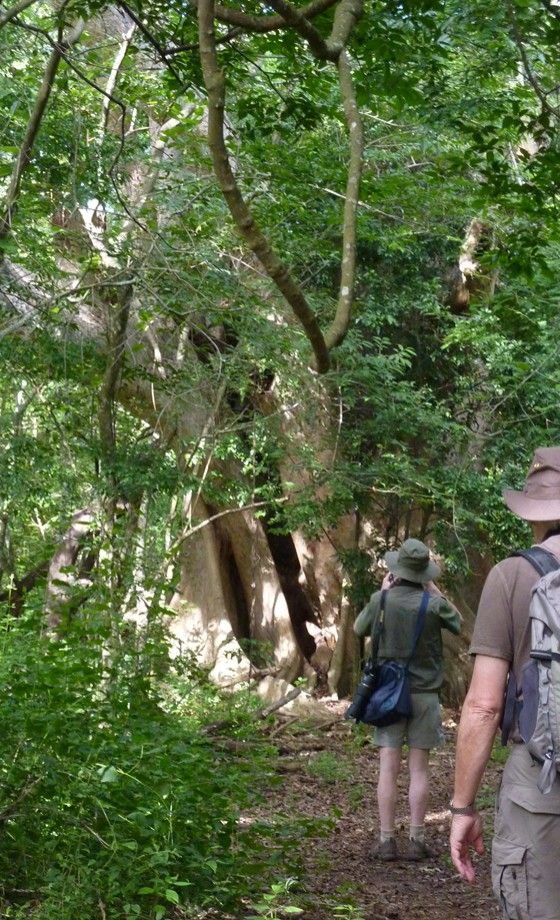
Some of the trees here were very large and extremely old. I think this one was over 400 years old.
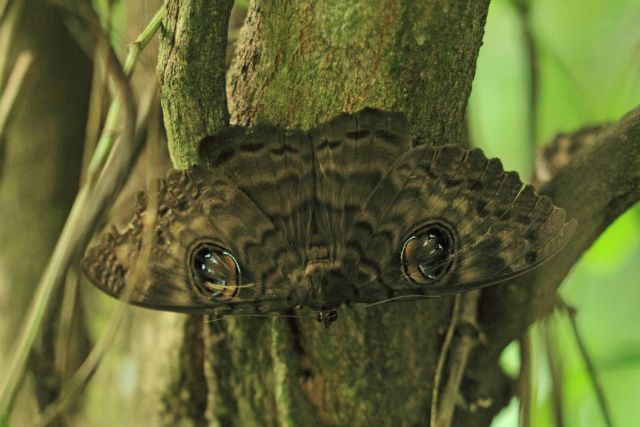
This very large moth was on one of the trunks. I'd guess it's wingspan was 7 inches or more.
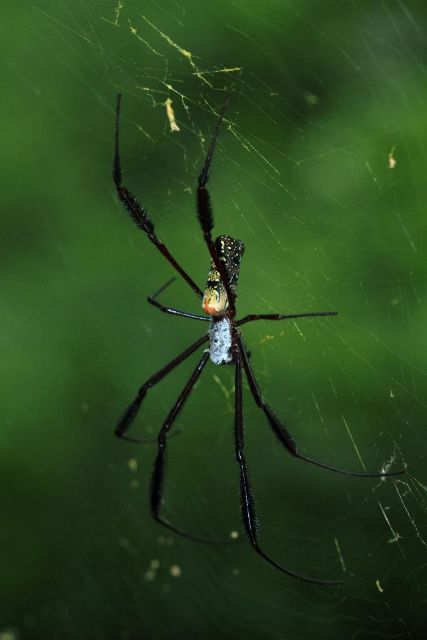
The middle of the forest was an excellent spot for large spiders, including this Orb Spider.
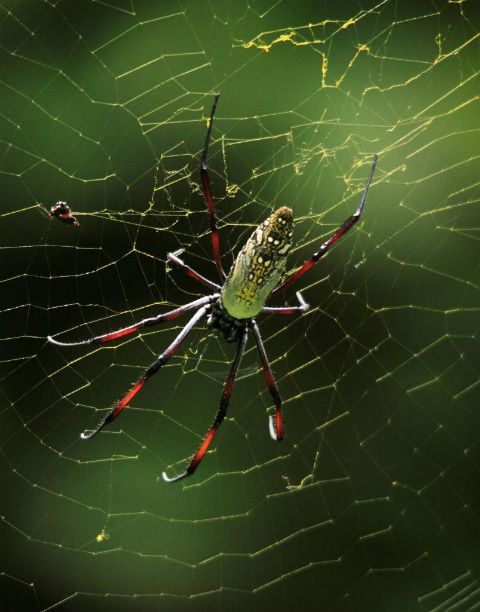
Another large Orb Spider. I think this one is quite beautiful - though luckily we never walked straight into one of the webs...
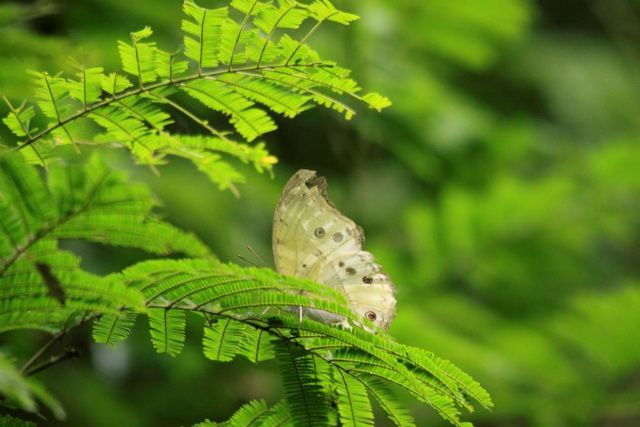
There were some fast-flying large butterflies in the middle of the forest such as Emperors, but they didn't stop.
Also perching above our heads was this slightly battered Common Mother-of-Pearl butterfly.
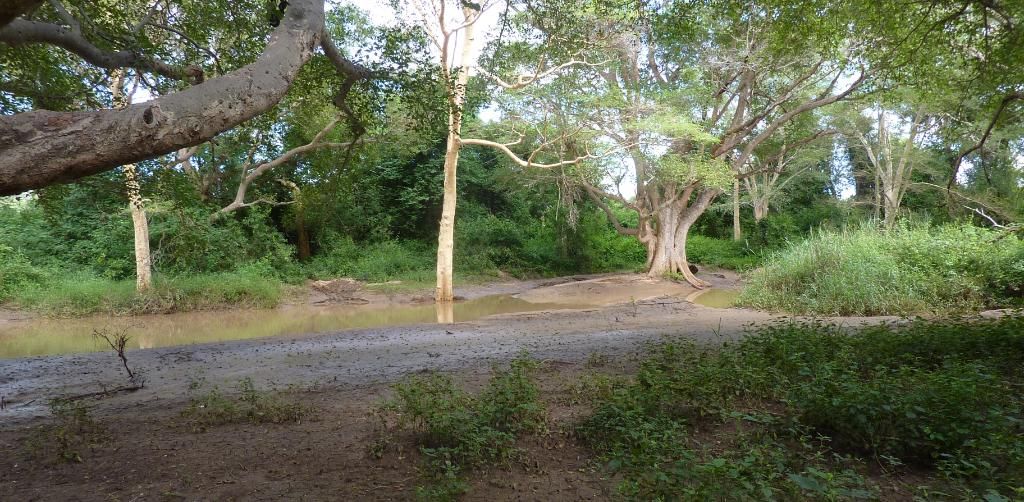
I did expect to see more at the rivers edge, but perhaps the temperatures weren't yet warm enough for mud-puddling butterflies.
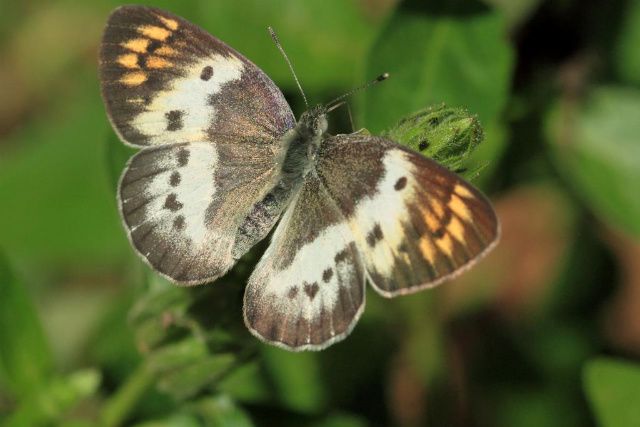
Exiting the walk we re-entered the track through the bushes at the start. The butterflies were now too active!
This one is a female Scarlet Tip.
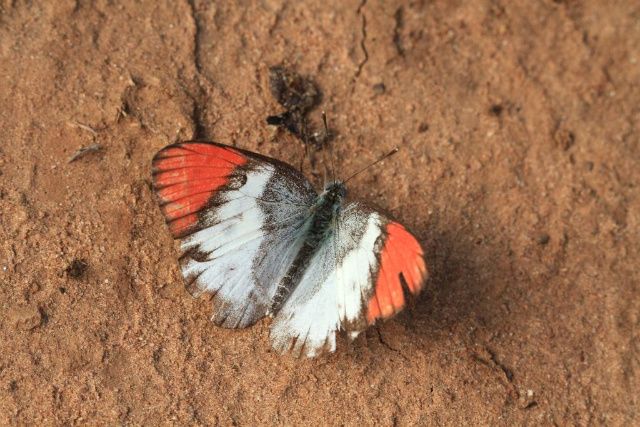
The male of the Scarlet Tip. This one was a little tatty but there were some beautifully bright ones about.
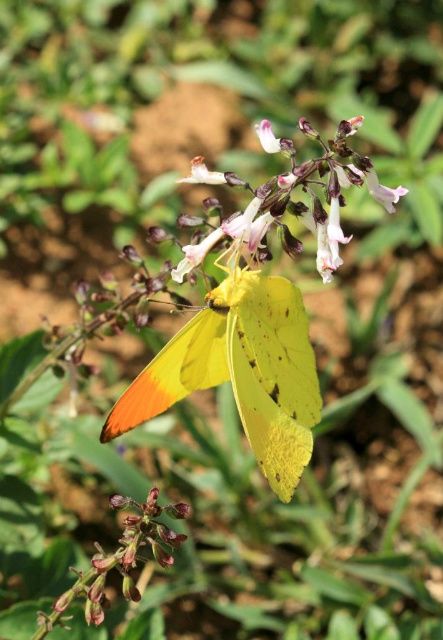
Possibly an Autumn-leaf Vagrant, also called the Orange-and-Lemon Butterfly (a good description).
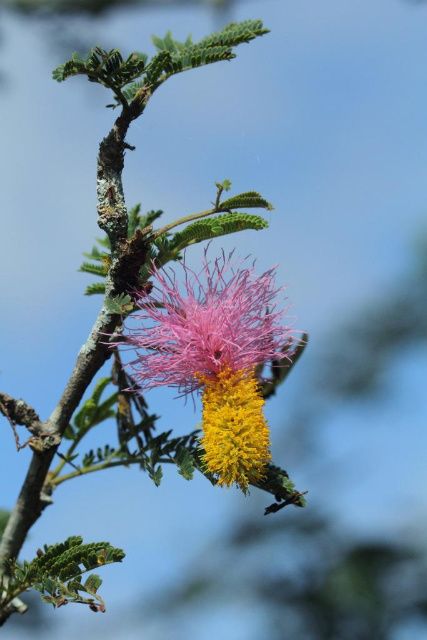
One of the few flowers that were on the bushes near the entrance of the walk.
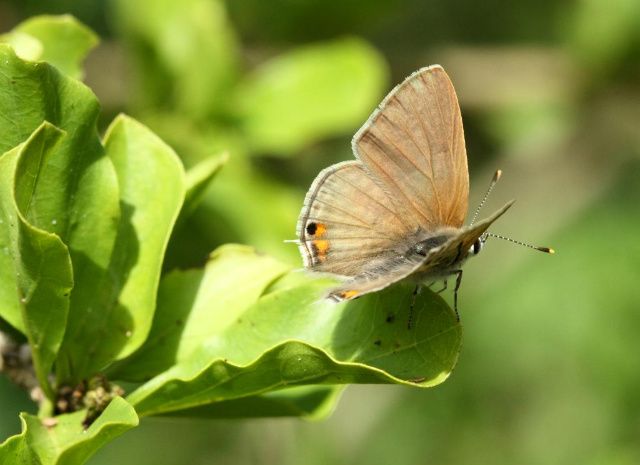
The Black-Striped Hairtail seen earlier in the day was now more active and opening it's wings.

In this shot you can still see the quite distinctive underside wing pattern. Typical 'Hairstreak-like' behavour!

A Green-Banded Swallowtail stops very briefly on one of the higher bushes. This was the only shot I could get!
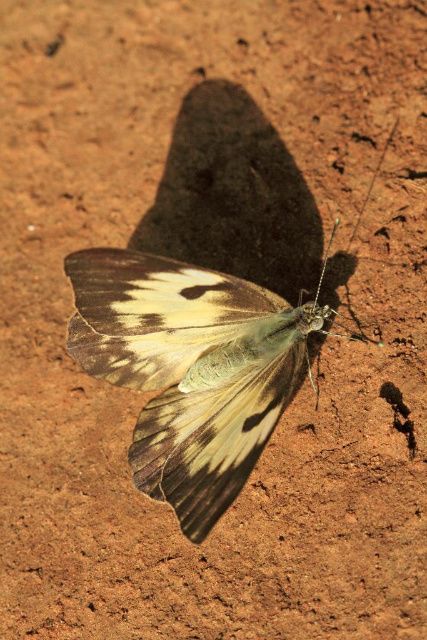
An African Veined White (female) on the dirt path.
Steve Woodhall has confirmed this ID plus a few that needed correction...
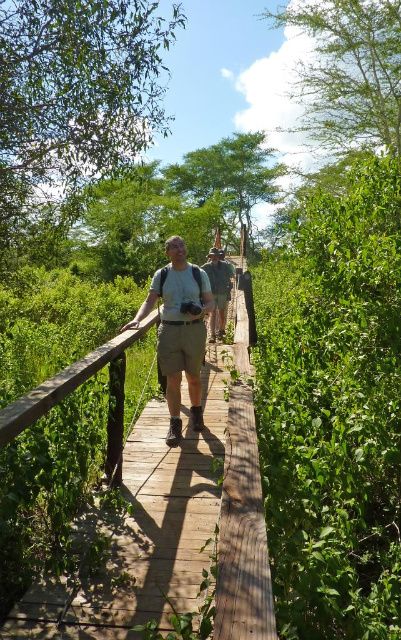
Karen snapped me leaving one of the last rickety bridges. Rickety bit of bridge not shown!
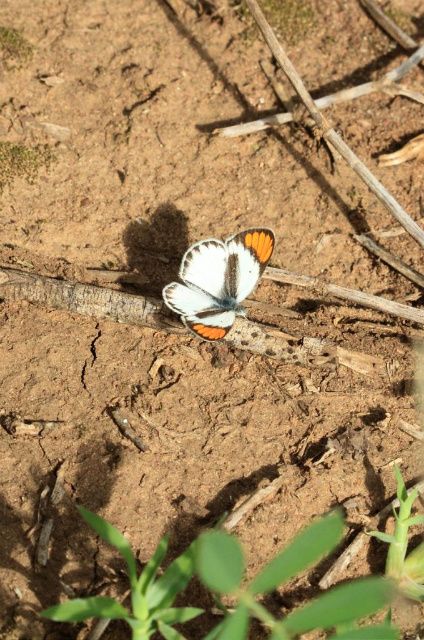
The Bushveld Orange tips were now active and difficult to photograph. This was a long-distance attempt!

The space in the car park as we are leaving the Fig-Forest walk - now full of the early morning sun and the temperatures are a lot higher!
As we walked further into the forest we would see more larger butterflies but these would also stay well above our heads: there were also a whole host of gorgeous spiders – some small, some very large – I noted that their webs were above head-height, perhaps to avoid being continually ‘taken down’ by the various mammals in the forest. There were also plenty of African Wood Whites (like our own Wood White, very difficult to photograph due to their meandering flight) and quite a few small orange butterflies within the thicker woods. These were later identified as the Spotted Buff butterfly (at the time I wasn’t entirely sure if they were butterflies or moths). We also saw what looked liked several large individuals of species of the Charaxinae (the Emperors) but few of these were stopping, and also several Leopard butterflies and some ‘Commodore’ individuals of the Nymphalidae species – unfortunately many of these were flying around the river plants as we crossed back via the wooden bridges – so no photos were possible (I was actually quite glad to get across the bridges with my camera still in my hand, I did have visions of the camera falling straight out of my hand into the river, due to the vibrations/movement of the rickety bridge!).
By the time we left the Fig-forest walk (around 9:30 am) the sun had come out properly and the earlier species near to the woodland edges were all a lot more active and now difficult to photograph due to their speed. So with the rangers pushing us ever onwards to the exit (in a professional manner) I resorted to some quick ‘point and shot’ shots that were simply the best I could do in the circumstances. Linda did a good job of spotting a Green-Banded Swallowtail in the distant bushes – a quick shot from a distance was all we’d get - and all too soon our walk in the Fig-forest was over. In just over a couple of hours I had seen more species here than in the whole of the rest of the SA trip so far.

A Smoky Orange Tip (male). This was one of the last of the whites I saw before we entered the thicker section of the forest.

Further into the forest there was much lower light and less open space.
African Wood Whites and this Spotted Buff butterfly were quite common in this area.

Some of the trees here were very large and extremely old. I think this one was over 400 years old.

This very large moth was on one of the trunks. I'd guess it's wingspan was 7 inches or more.

The middle of the forest was an excellent spot for large spiders, including this Orb Spider.

Another large Orb Spider. I think this one is quite beautiful - though luckily we never walked straight into one of the webs...

There were some fast-flying large butterflies in the middle of the forest such as Emperors, but they didn't stop.
Also perching above our heads was this slightly battered Common Mother-of-Pearl butterfly.

I did expect to see more at the rivers edge, but perhaps the temperatures weren't yet warm enough for mud-puddling butterflies.

Exiting the walk we re-entered the track through the bushes at the start. The butterflies were now too active!
This one is a female Scarlet Tip.

The male of the Scarlet Tip. This one was a little tatty but there were some beautifully bright ones about.

Possibly an Autumn-leaf Vagrant, also called the Orange-and-Lemon Butterfly (a good description).

One of the few flowers that were on the bushes near the entrance of the walk.

The Black-Striped Hairtail seen earlier in the day was now more active and opening it's wings.

In this shot you can still see the quite distinctive underside wing pattern. Typical 'Hairstreak-like' behavour!

A Green-Banded Swallowtail stops very briefly on one of the higher bushes. This was the only shot I could get!

An African Veined White (female) on the dirt path.
Steve Woodhall has confirmed this ID plus a few that needed correction...

Karen snapped me leaving one of the last rickety bridges. Rickety bit of bridge not shown!

The Bushveld Orange tips were now active and difficult to photograph. This was a long-distance attempt!

The space in the car park as we are leaving the Fig-Forest walk - now full of the early morning sun and the temperatures are a lot higher!
Last edited by Michaeljf on Mon Mar 26, 2012 6:31 pm, edited 2 times in total.
- Neil Freeman
- Posts: 4443
- Joined: Fri Jul 23, 2010 6:25 pm
- Location: Solihull, West Midlands
Re: South Africa trip with Naturetrek (10-18 March)
Hi Michael,
Excellent thread and really interesting. I will be going back to the beginning and reading through this again when I have more time to appreciate it.
All the best,
Neil F.
Excellent thread and really interesting. I will be going back to the beginning and reading through this again when I have more time to appreciate it.
All the best,
Neil F.
Re: South Africa trip with Naturetrek (10-18 March)
Thanks Neil 
Mkuze Reserve (Monday, 12th March) continued...
Our drive back to base was accompanied by some good views of our first Giraffes of the trip. Once we’d finished a late breakfast we visited the Mkuze lake again (there were plenty of good birds such as Flamingos and Osprey around the lake - but all were a long distance away and only via Bert’s excellent scope allowed us to see them) and I did manage to see a couple of new butterfly species (Brown Pansy). We also did try to visit a hide by one of the smaller ponds, but the hide was closed for refurbishing / rebuilding.
On the return from the abandoned hide visit, I would see several of the Purple-Brown Hairstreak on the small spiked bushes, and a very small individual of the Almeida (Copper) group egg-laying on grass stems very very close to the ground. The end of the day came too soon and it was a shame the rest of the day hadn’t quite lived up to the first couple of hours, nevertheless the day finished on a high note with an Eagle Owl flying about 10 yards above Karen’s head as we were getting ready to go out for the evening meal. Our evening meal was excellent and again provided by our hosts (who own and help run the Lawsons wildlife SA tours). We also dined with a bird-spotting group that were also being led by a trained bird-and-wildlife guide who worked for Lawsons. We settled back in the tents for the night and unfortunately would leave the Mkuze reserve tomorrow (Tuesday) as we would move on to our next venue.
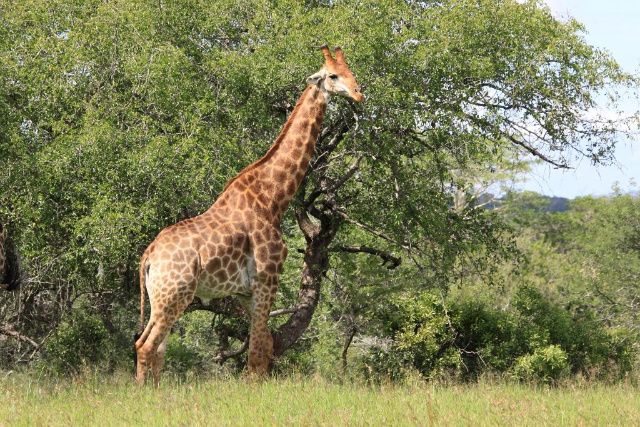
Our first proper view of Giraffes in the Mkuze reserve.
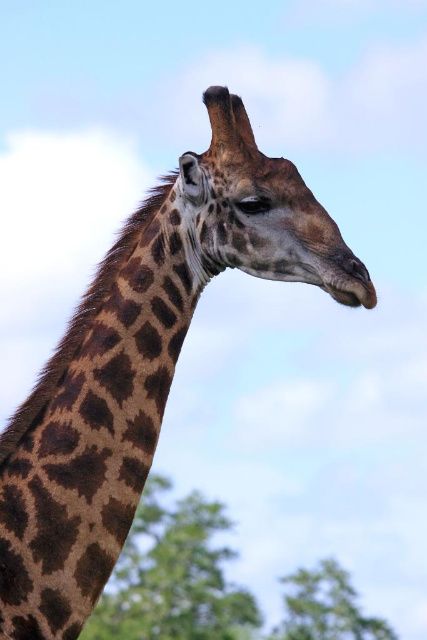
A close-up of one of the elegant Giraffes...

They seem to be fantastically relaxing to watch, and very affectionate to each other...

The beautiful lake in the Mkuze reserve: not as pretty as during our first visit in first light, but a nice place to stop nevertheless...
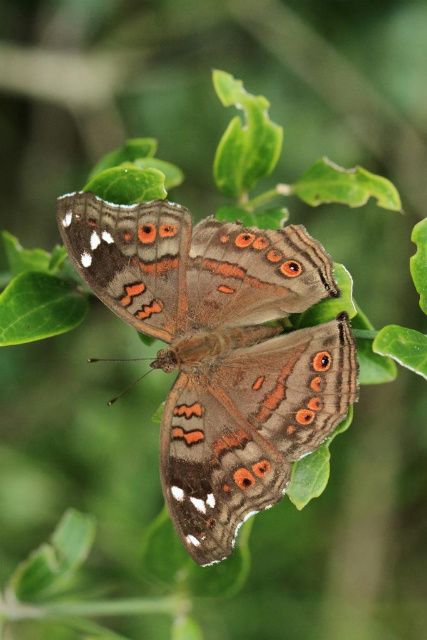
At the lake we found a few new species including this Brown Pansy.

A Smoky Orange Tip also round the bushes right next to the Mkuze lake.
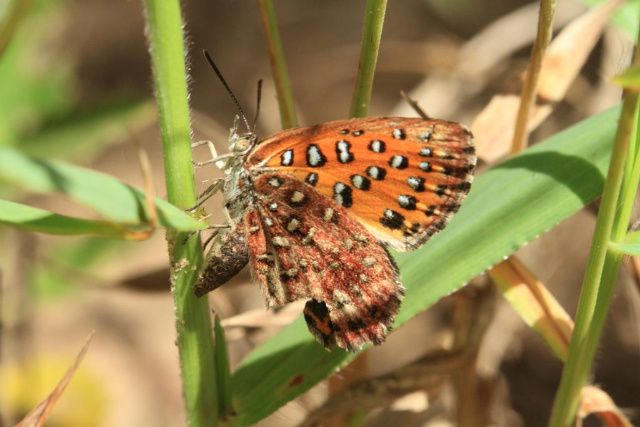
This is the Small Copper butterfly that seemed to be egg-laying at the bottom of the grass: possibly a Dusky Copper.
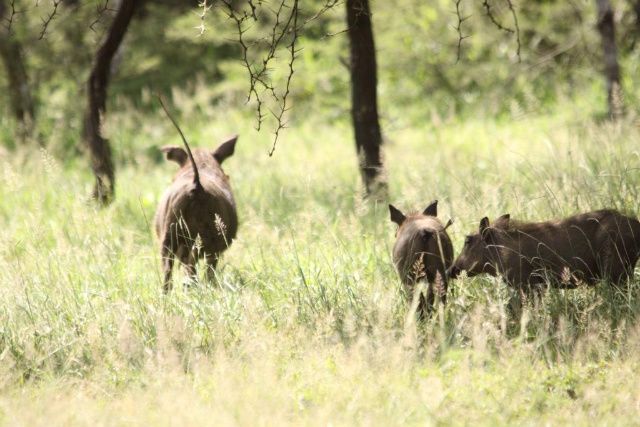
On one of our journeys back to camp we saw this family of Warthogs - far to quick to stay for a photo.
What we ended up calling a 'bum' shot.
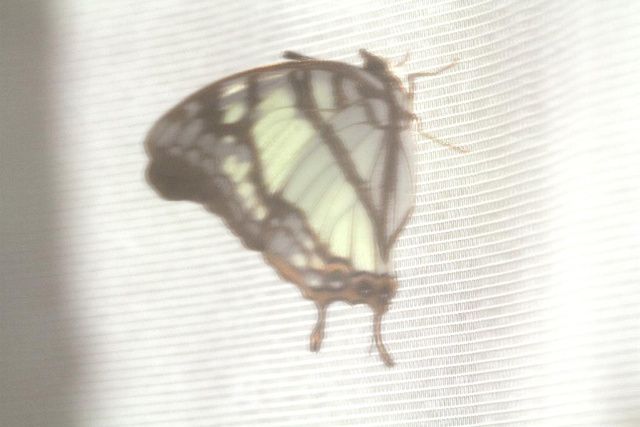
Back at our hosts house on the reserve they had set out a small net and some fruit bait for the butterflies.
This is a Club-Tailed Emperor (photographed through the netting), and would be released after we'd ID' the butterfly.

Last proper photo of Mondays adventure - a small Dragonfly near to our tent. No shot of our Eagle Owl, unfortunately...
Mkuze Reserve (Monday, 12th March) continued...
Our drive back to base was accompanied by some good views of our first Giraffes of the trip. Once we’d finished a late breakfast we visited the Mkuze lake again (there were plenty of good birds such as Flamingos and Osprey around the lake - but all were a long distance away and only via Bert’s excellent scope allowed us to see them) and I did manage to see a couple of new butterfly species (Brown Pansy). We also did try to visit a hide by one of the smaller ponds, but the hide was closed for refurbishing / rebuilding.
On the return from the abandoned hide visit, I would see several of the Purple-Brown Hairstreak on the small spiked bushes, and a very small individual of the Almeida (Copper) group egg-laying on grass stems very very close to the ground. The end of the day came too soon and it was a shame the rest of the day hadn’t quite lived up to the first couple of hours, nevertheless the day finished on a high note with an Eagle Owl flying about 10 yards above Karen’s head as we were getting ready to go out for the evening meal. Our evening meal was excellent and again provided by our hosts (who own and help run the Lawsons wildlife SA tours). We also dined with a bird-spotting group that were also being led by a trained bird-and-wildlife guide who worked for Lawsons. We settled back in the tents for the night and unfortunately would leave the Mkuze reserve tomorrow (Tuesday) as we would move on to our next venue.

Our first proper view of Giraffes in the Mkuze reserve.

A close-up of one of the elegant Giraffes...

They seem to be fantastically relaxing to watch, and very affectionate to each other...

The beautiful lake in the Mkuze reserve: not as pretty as during our first visit in first light, but a nice place to stop nevertheless...

At the lake we found a few new species including this Brown Pansy.

A Smoky Orange Tip also round the bushes right next to the Mkuze lake.

This is the Small Copper butterfly that seemed to be egg-laying at the bottom of the grass: possibly a Dusky Copper.

On one of our journeys back to camp we saw this family of Warthogs - far to quick to stay for a photo.
What we ended up calling a 'bum' shot.

Back at our hosts house on the reserve they had set out a small net and some fruit bait for the butterflies.
This is a Club-Tailed Emperor (photographed through the netting), and would be released after we'd ID' the butterfly.

Last proper photo of Mondays adventure - a small Dragonfly near to our tent. No shot of our Eagle Owl, unfortunately...
- Lee Hurrell
- Stock Contributor

- Posts: 2423
- Joined: Mon May 25, 2009 7:33 pm
- Location: Hampshire
Re: South Africa trip with Naturetrek (10-18 March)
Another stunning set, Michael.
Really enjoying your report!
Lee
Really enjoying your report!
Lee
To butterfly meadows, chalk downlands and leafy glades; to summers eternal.
- Paul Wetton
- Posts: 780
- Joined: Mon Jul 26, 2010 8:07 am
- Contact:
Re: South Africa trip with Naturetrek (10-18 March)
Keep it coming Michael. A great read with some great photos. Most enthralling.
Cheers Paul
_____________________________________________________________________________
http://www.wildlife-films.com http://www.ibirdz.co.uk
_____________________________________________________________________________
http://www.wildlife-films.com http://www.ibirdz.co.uk
Re: South Africa trip with Naturetrek (10-18 March)
Hi Paul / Lee,
thanks for your kind comments as always. Although sometimes it's a bit of hard work going through everything (including choosing and resizing photos and checking ID's) it's quite nice for me to confirm species we saw while everything is still quite recent in my mind. Steve Woodhall has thankfully checked my butterfly ID's and I've only got a couple wrong so far, which I'm amending as I go!
Hopefully there should be some more trip diary entries to come tonight.
Michael
thanks for your kind comments as always. Although sometimes it's a bit of hard work going through everything (including choosing and resizing photos and checking ID's) it's quite nice for me to confirm species we saw while everything is still quite recent in my mind. Steve Woodhall has thankfully checked my butterfly ID's and I've only got a couple wrong so far, which I'm amending as I go!
Hopefully there should be some more trip diary entries to come tonight.
Michael
- Paul Wetton
- Posts: 780
- Joined: Mon Jul 26, 2010 8:07 am
- Contact:
Re: South Africa trip with Naturetrek (10-18 March)
Great stuff Michael, awaiting with baited breath.
Cheers Paul
_____________________________________________________________________________
http://www.wildlife-films.com http://www.ibirdz.co.uk
_____________________________________________________________________________
http://www.wildlife-films.com http://www.ibirdz.co.uk
Re: South Africa trip with Naturetrek (10-18 March)
And so am I...I've just 'found' this thread and I enjoyed reading it!!!
More please, and of the birds too!
Gibster.
More please, and of the birds too!
Gibster.
Raising £10,000 for Butterfly Conservation by WALKING 1200 miles from Land's End to John O'Groats!!!
See http://www.justgiving.com/epicbutterflywalk or look up Epic Butterfly Walk on Facebook.
See http://www.justgiving.com/epicbutterflywalk or look up Epic Butterfly Walk on Facebook.
Re: South Africa trip with Naturetrek (10-18 March)
Final morning at Mkuze Reserve and drive to St Lucia (Monday, 13th March)
For our final morning at the Mkuze reserve on Tuesday we again rose early, but not as early as the previous day! Again there had been rain during the night but on this morning the sky was beautifully clear and bright sunshine started coming through as soon as we were starting our morning drive round the reserve at around 7am. Our first views were of numerous birds including a beautiful Golden-Tailed Woodpecker that was in a small bush right next to the minibus. As we drove on we again passed Plains Zebra, Giraffe, Wildebeest and Impala but this morning there were also quite a few small water pools in the road and we would see some small birds such as the Blue Waxbill and later Green-Winged Pytilia taking early baths or drink from the puddles. There was also the lovely sight of Little Bee-Eaters on the bushes out on the plain, but too far for good photographs unfortunately. Definitely at that distance these were birds that could only really be seen with binoculars or a good scope rather than the camera.

The sun is just breaking through the trees at the Mkuze reserve, with the prospect of clear skies and a hot day..
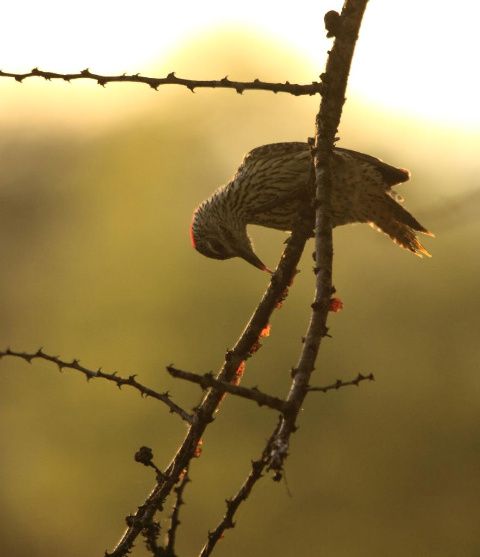
One of our first views in the nearby bushes is of a Golden-Tailed Woodpecker.
This time I was lucky enough to be close enough for a good photograph.
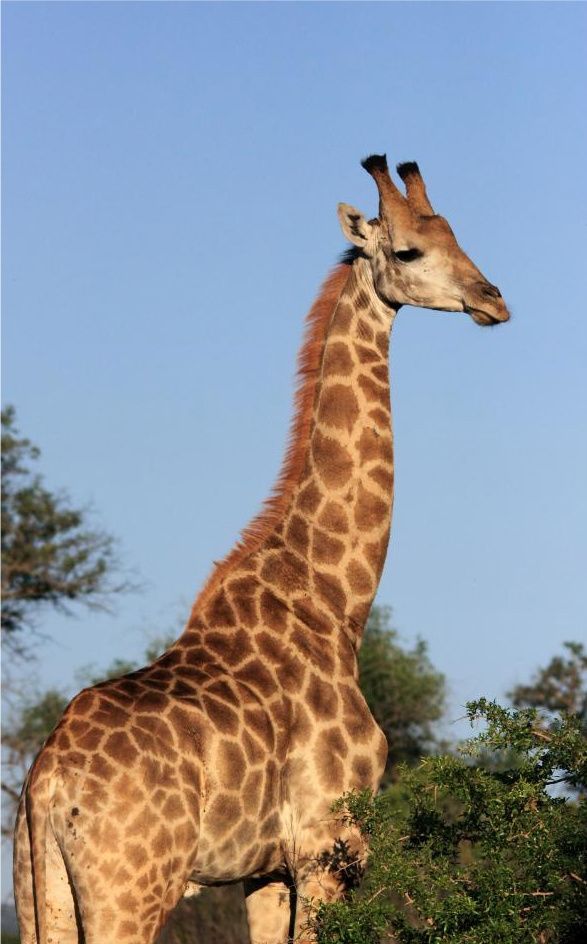
The Giraffes were still walking about, just off the road, in ones and twos. They are what I'd call 'gently inquisitive' about us too.

As always, the Impala are never far away and are often crossing the road in small 'schools' of the same age groups.
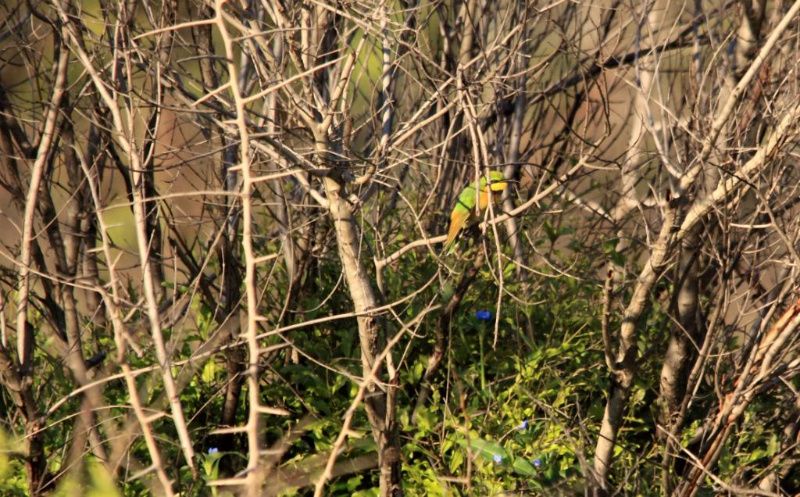
We can only get long-distance views of the Little Bee-Eaters but all the same they are a lovely sight.
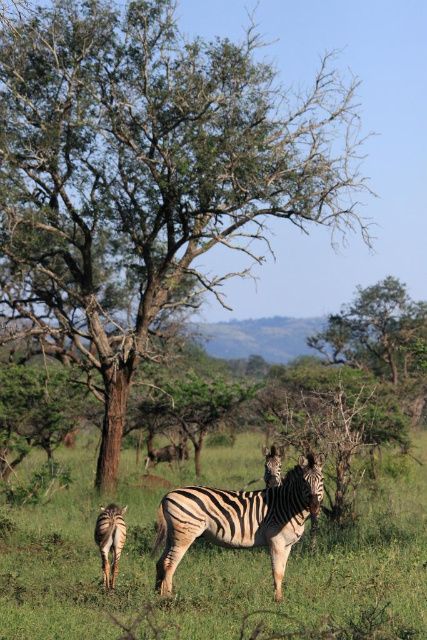
Our views of the Plains Zebras would be a lot better this morning because of the clear light.
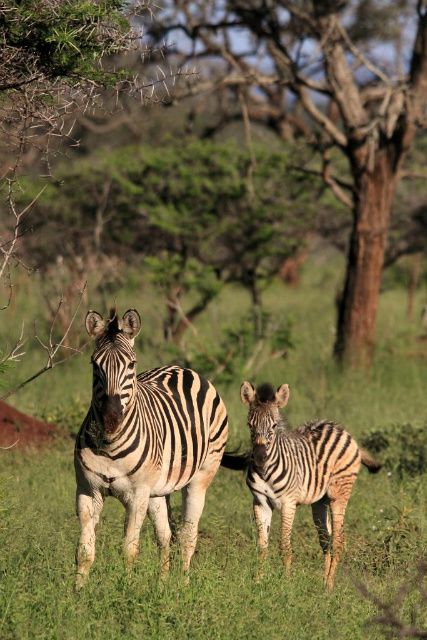
Mother and Foal make a nice picture. There are Wildebeest behind but I never get a clear view!
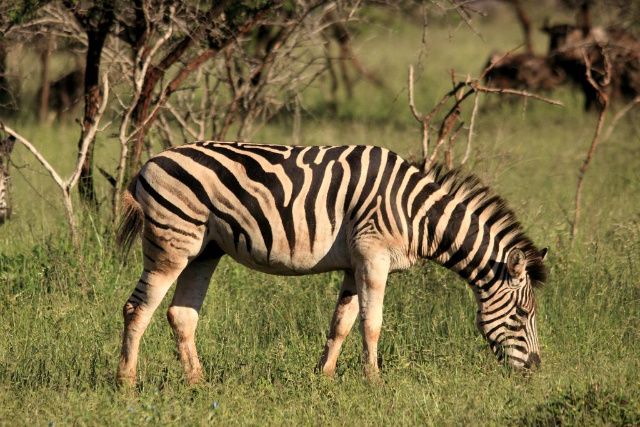
This looks like a good life. Unless you get eaten by a predator, of course.
The reason the Wildebeest and Zebras make good companions is that they are good look-outs for the predators.
We were driven down a small path through a more enclosed woodland ride and I would continually catch glimpses of white butterflies plus the occasional Hairtail / Hairstreak and Citrus Swallowtail basking in the early morning light on the smaller bushes. Suddenly we turned a corner and we were face-to-face with a Rhino and her Calf, probably only 20 yards in front of the minibus. We stayed watching these Rhinos for about 10 minutes and then, seeing as this was the only way out of the woodland ride, we gently moved closer hoping to pass the rhinos. I was in the front seat and suddenly had the feeling that the mother Rhino might suddenly ‘take a run at us’....luckily she didn’t and mother and the youngster both wandered off into the shrub, making a new path into the bushes. Surely this was one of the most memorable close views we’d had at the Mkuze reserve and it seems very sad that poaching is still taking so many of these beautiful creatures.

Once again we would see Citrus Swallowtails - this time, just warming up on the bushes.
I did wonder why I wouldn't be allowed out of the minibus to get a closer look.
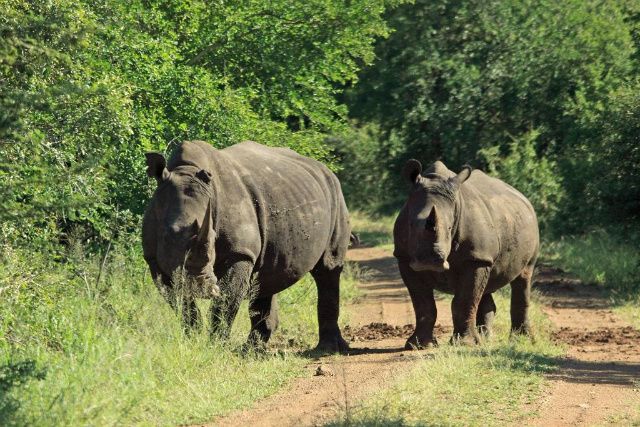
This is probably the reason we don't get out of the minibus. A mother Rhino and her Calf about 20 yards in front of us.
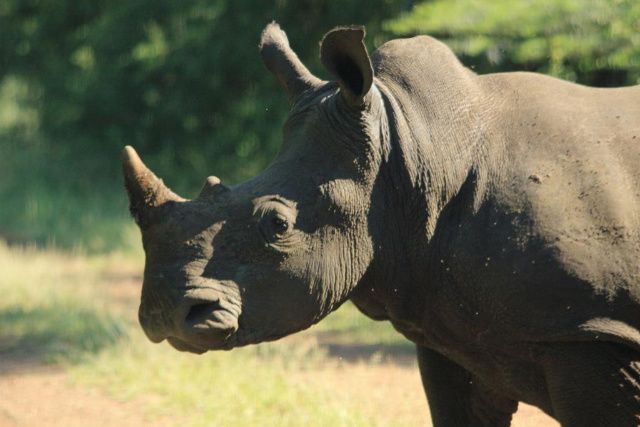
Beautiful creatures. You can't imagine why anyone would kill these wonderful animals.
Before we would get back for a late breakfast at our hosts guesthouse, we would also see more of the Blue Waxbills (too small to photograph from the minibus) and also a Brown-Hooded Kingfisher just off the ride as we passed next to a forest stream. Once back at the house for breakfast I would watch several small butterflies just above our heads in the garden trees – these were Striped Policeman – very similar looking to some of our best Skippers – but these were a bit too high to get a good photograph. After breakfast all our party had packed our bags so we loaded up the Minibus for the trip to our next guesthouse location at St Lucia. Our guide, Bert, had however luckily left time for a few more stops in the Minibus as we drove out of the Mkuze reserve.
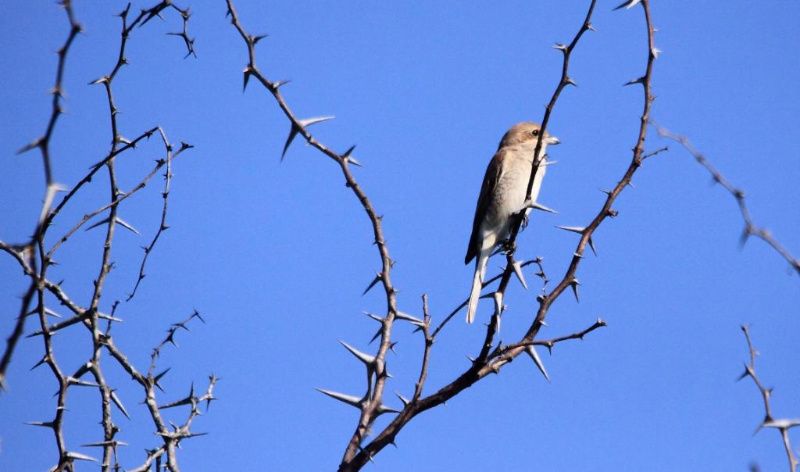
We would continue to see small birds as we drove through the reserve.
This may be a Female Red-Backed Shrike but I'm not sure.
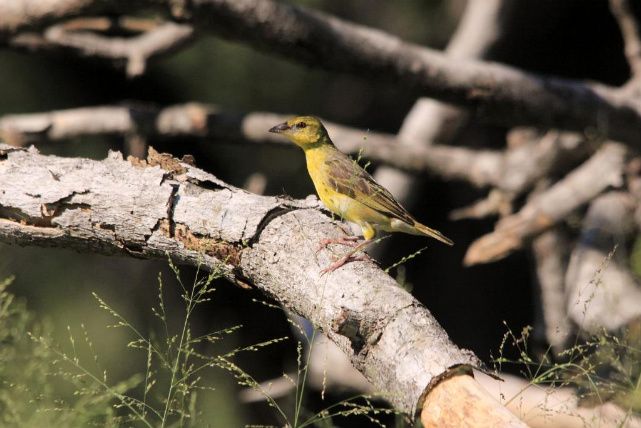
I'm also not sure of this one - possibly a Lesser Masked Weaver (female).
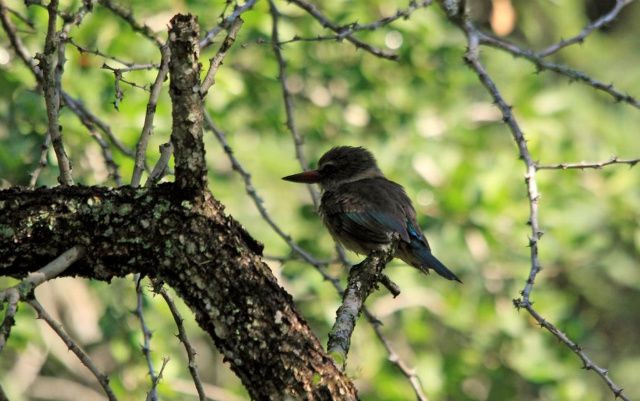
A Brown-Hooded Kingfisher just in the shaded bushes as we stop near a small stream.
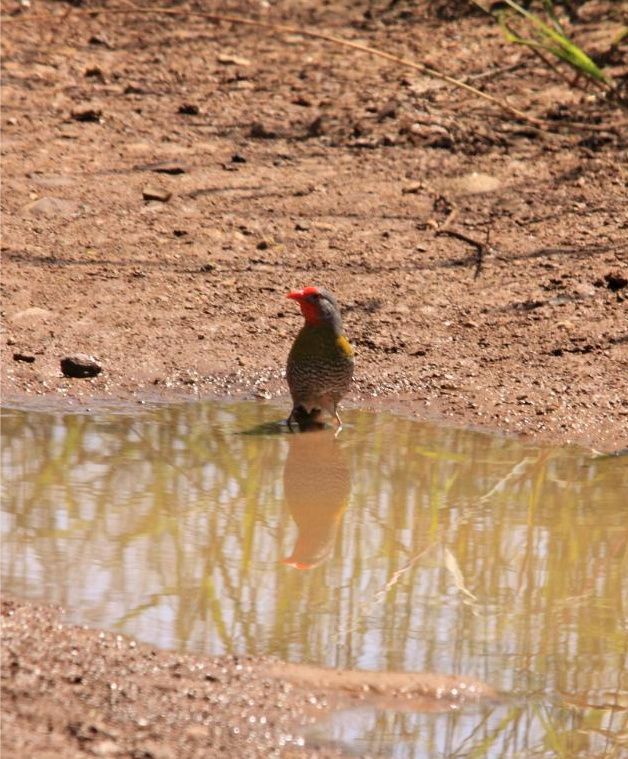
A Green-Winged Pytilia getting an early morning drink. It was going to be a hot day today..
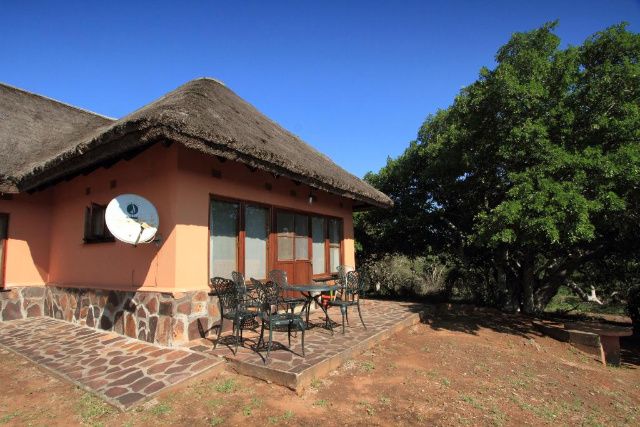
Finally back at our hosts guesthouse for our last breakfast at Mkuze.
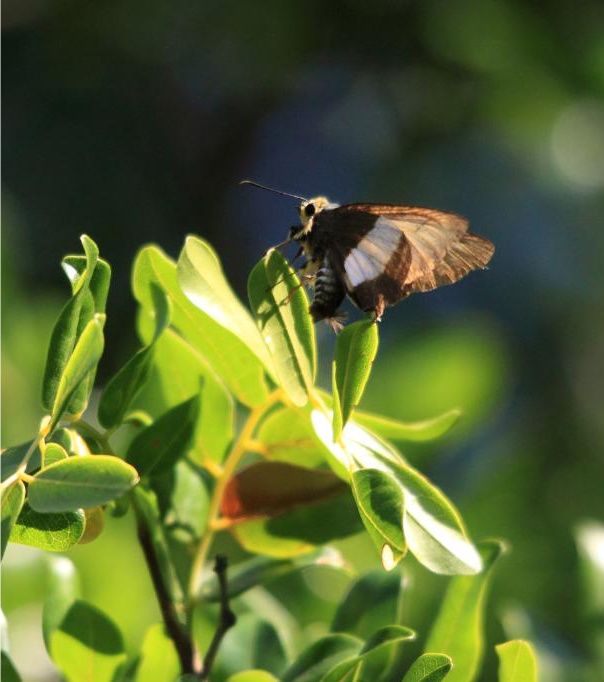
One of the Striped Policeman, up in the trees in our hosts' garden. Only just near enough for an ID picture...
For our final morning at the Mkuze reserve on Tuesday we again rose early, but not as early as the previous day! Again there had been rain during the night but on this morning the sky was beautifully clear and bright sunshine started coming through as soon as we were starting our morning drive round the reserve at around 7am. Our first views were of numerous birds including a beautiful Golden-Tailed Woodpecker that was in a small bush right next to the minibus. As we drove on we again passed Plains Zebra, Giraffe, Wildebeest and Impala but this morning there were also quite a few small water pools in the road and we would see some small birds such as the Blue Waxbill and later Green-Winged Pytilia taking early baths or drink from the puddles. There was also the lovely sight of Little Bee-Eaters on the bushes out on the plain, but too far for good photographs unfortunately. Definitely at that distance these were birds that could only really be seen with binoculars or a good scope rather than the camera.

The sun is just breaking through the trees at the Mkuze reserve, with the prospect of clear skies and a hot day..

One of our first views in the nearby bushes is of a Golden-Tailed Woodpecker.
This time I was lucky enough to be close enough for a good photograph.

The Giraffes were still walking about, just off the road, in ones and twos. They are what I'd call 'gently inquisitive' about us too.

As always, the Impala are never far away and are often crossing the road in small 'schools' of the same age groups.

We can only get long-distance views of the Little Bee-Eaters but all the same they are a lovely sight.

Our views of the Plains Zebras would be a lot better this morning because of the clear light.

Mother and Foal make a nice picture. There are Wildebeest behind but I never get a clear view!

This looks like a good life. Unless you get eaten by a predator, of course.
The reason the Wildebeest and Zebras make good companions is that they are good look-outs for the predators.
We were driven down a small path through a more enclosed woodland ride and I would continually catch glimpses of white butterflies plus the occasional Hairtail / Hairstreak and Citrus Swallowtail basking in the early morning light on the smaller bushes. Suddenly we turned a corner and we were face-to-face with a Rhino and her Calf, probably only 20 yards in front of the minibus. We stayed watching these Rhinos for about 10 minutes and then, seeing as this was the only way out of the woodland ride, we gently moved closer hoping to pass the rhinos. I was in the front seat and suddenly had the feeling that the mother Rhino might suddenly ‘take a run at us’....luckily she didn’t and mother and the youngster both wandered off into the shrub, making a new path into the bushes. Surely this was one of the most memorable close views we’d had at the Mkuze reserve and it seems very sad that poaching is still taking so many of these beautiful creatures.

Once again we would see Citrus Swallowtails - this time, just warming up on the bushes.
I did wonder why I wouldn't be allowed out of the minibus to get a closer look.

This is probably the reason we don't get out of the minibus. A mother Rhino and her Calf about 20 yards in front of us.

Beautiful creatures. You can't imagine why anyone would kill these wonderful animals.
Before we would get back for a late breakfast at our hosts guesthouse, we would also see more of the Blue Waxbills (too small to photograph from the minibus) and also a Brown-Hooded Kingfisher just off the ride as we passed next to a forest stream. Once back at the house for breakfast I would watch several small butterflies just above our heads in the garden trees – these were Striped Policeman – very similar looking to some of our best Skippers – but these were a bit too high to get a good photograph. After breakfast all our party had packed our bags so we loaded up the Minibus for the trip to our next guesthouse location at St Lucia. Our guide, Bert, had however luckily left time for a few more stops in the Minibus as we drove out of the Mkuze reserve.

We would continue to see small birds as we drove through the reserve.
This may be a Female Red-Backed Shrike but I'm not sure.

I'm also not sure of this one - possibly a Lesser Masked Weaver (female).

A Brown-Hooded Kingfisher just in the shaded bushes as we stop near a small stream.

A Green-Winged Pytilia getting an early morning drink. It was going to be a hot day today..

Finally back at our hosts guesthouse for our last breakfast at Mkuze.

One of the Striped Policeman, up in the trees in our hosts' garden. Only just near enough for an ID picture...
- Paul Wetton
- Posts: 780
- Joined: Mon Jul 26, 2010 8:07 am
- Contact:
Re: South Africa trip with Naturetrek (10-18 March)
Excellent Michael, most enthralling, I'm enjoying every word and photo.
Not sure about the shrike as many females or young look very similar. I'll have a look in my books when I get home from work.
Not sure about the shrike as many females or young look very similar. I'll have a look in my books when I get home from work.
Cheers Paul
_____________________________________________________________________________
http://www.wildlife-films.com http://www.ibirdz.co.uk
_____________________________________________________________________________
http://www.wildlife-films.com http://www.ibirdz.co.uk
Re: South Africa trip with Naturetrek (10-18 March)
Hi Paul,Paul Wetton wrote:Excellent Michael, most enthralling, I'm enjoying every word and photo. Not sure about the shrike as many females or young look very similar. I'll have a look in my books when I get home from work.
many thanks - if folks are getting enjoyment from the thread that's a really nice bonus. Don't worry too much about the Shrike ID - Richard Pooley, who was also in our group, is very good on birds and he will probably have no problem ID'ing both of the birds that I'm not sure about. I've got to contact him soon about the next days sightings (Wednesday 14th March) as he may have photographed one of the species that eluded me, and I'd like to include a brief picture in the day's proceedings if he has one....
Michael
P.S. for all the species I've managed to show, there are plenty that I missed that would have been great (the Blue Waxbills for example!). Also we have quite a bit of HD camcorder footage and at some point we may be able to upload some short sequences to add to the reports here...
- Paul Wetton
- Posts: 780
- Joined: Mon Jul 26, 2010 8:07 am
- Contact:
Re: South Africa trip with Naturetrek (10-18 March)
I probably wouldn't have been able to ID the shrike without seeing it in the flesh anyway. Roll out the camcorder footage, can't wait.
Cheers Paul
_____________________________________________________________________________
http://www.wildlife-films.com http://www.ibirdz.co.uk
_____________________________________________________________________________
http://www.wildlife-films.com http://www.ibirdz.co.uk
Re: South Africa trip with Naturetrek (10-18 March)
Final morning at Mkuze Reserve and drive to St Lucia (Monday, 13th March)- continued...
Just before leaving our hosts guesthouse, I was shown one of the local Leopard Tortoises that were one of the ‘small five’ of South Africa. Another great creature I saw at the house were the many dung beetles that could be seen hard at work on the dry soil, gathering their daily bit of faecal matter...they were such hard, speedy workers I couldn’t even get a good photo of them. And it was time to leave!
Our guide, Bert, stopped off twice while driving through to the South-East exit of the Mkuze reserve: once to check out one of the small hides, and once next to a small lake (Muze Pan) right by the edge of the forest boundary. For the first stop by the hide – while the rest of the group went to the hide, Karen and I checked out the butterflies that were flying about on the scrub edges of the car-park by the hide entrance: there were a pair of the Club-Tailed Emperors in the trees (the species that had been attracted to the fruit-trap the previous day), plus several whites and also some fleeting re-appearance of the Green-Banded Swallowtails that again wouldn’t stop for any reasonable length of time. If there were disadvantages in to trying to see the larger butterflies in the Mkuze reserve and grasslands, one of those would be the lack of any large flowering bushes to slow down large butterflies such the Swallowtails. Also on our drive out of the Mkuze reserve we would finally see a few butterflies mud-puddling or feeding off the remains of the animal scats. Proof that it was a hot day, rather than just humid!
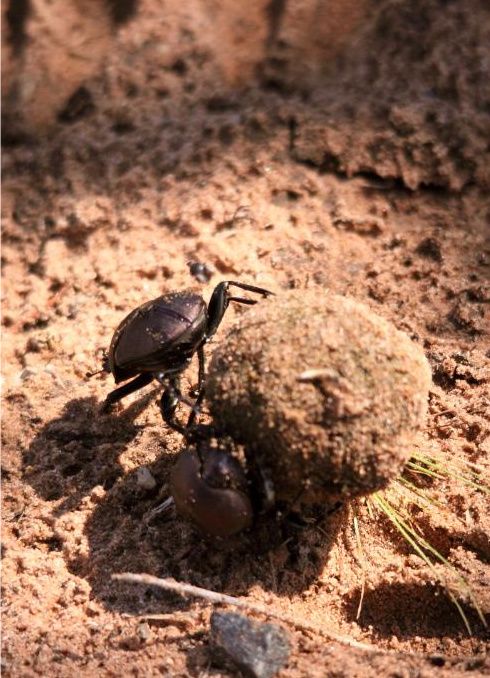
Dung Beetles doing what comes naturally to them, just outside our hosts guesthouse at Mkuze.
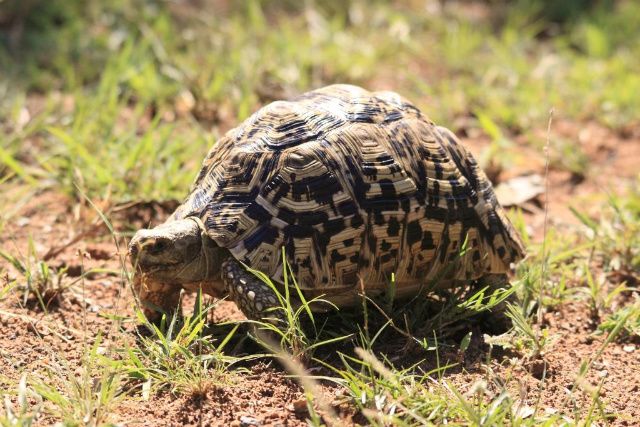
One of the 'small five' in South Africa - the Leopard Tortoise. A surprisingly quick mover!
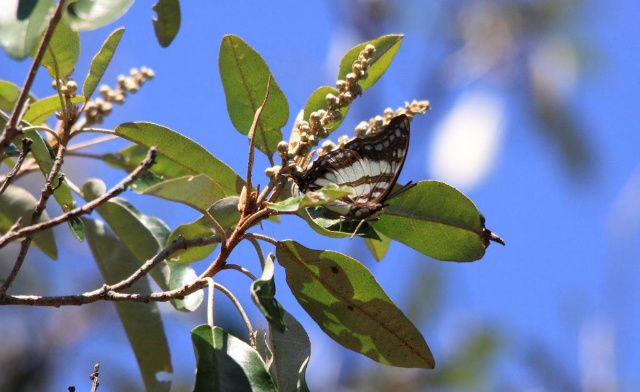
The male Club-Tailed Emperor viewed in one of the small hide car-parks at Mkuze.
A beautiful butterfly, but like our Emperors, quite keen to stay out of good camera-shot.
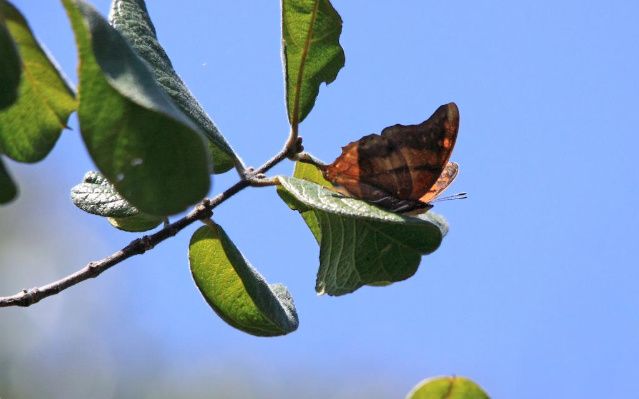
The female Club-Tailed Emperor at the same spot. A very different colour, but the same outline.

Also at the same spot was this Zebra White. Temperatures are quite hot by this point and all the butterflies are skittish!
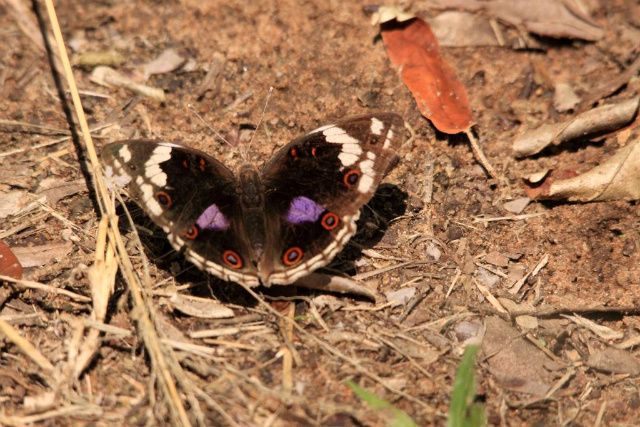
A Blue Pansy at the same location. Slightly out-of-focus unfortunately, but quite pretty nonetheless...
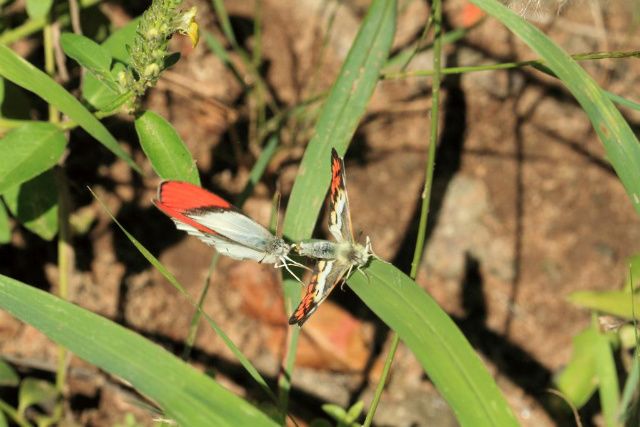
These are two Crimson Tip butterflies mating: the male is a lot bigger and brighter.
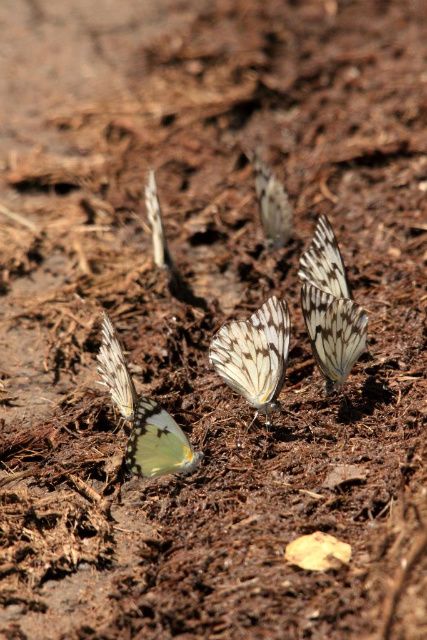
Driving onward towards the southeastern edge of Mkuze, there are finally a few butterflies either mud-puddling or dung-revelling..
Our second stop out of the Mkuze reserve was at the small lake at Muzi Pan (bordering on the Isimangaliso Wetland Park World Heritage Site). This was a good stop for the bird-watchers as there were several interesting birds such as in the lake (including Pelican, Cormorant, Heron, Egret, Stork Ibis and duck), a single Malachite Kingfisher (very small) and also several Hippopotamus just under the water’s surface. These were mostly quite a distance away and seeing the birds through the scope was the only really good way of observing them. While the group were looking at the birds, I would however wander round the low-grass and scrub just on the edges of the lake (you can see a pattern emerging here). Walking round the lake’s edge I found several small Blues and also a beautiful small Copper that I wouldn’t identify until I returned home. After leaving the south-eastern edge of the Mkuze reserve we had the chance to see plenty of the local villagers near Hluhluwe: Bert explained that their Nguni cattle were indigenous and renowned for their hardiness (in some cases if the Nguni cattle were born with particular pattern / colours they would immediately be seen as belonging to the line of Zulu royalty).
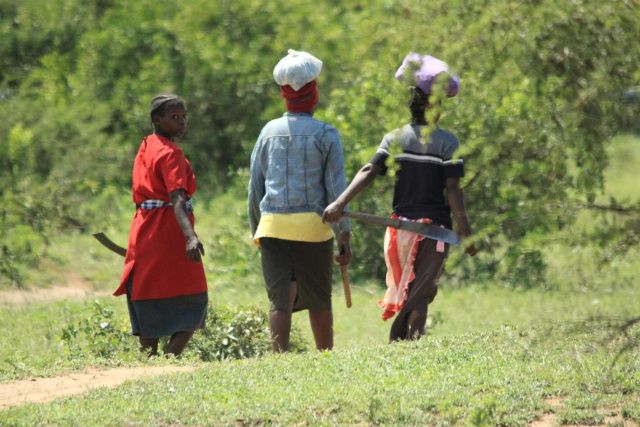
Local Village girls as we edge into the end of the Mkuze Reserve and approach the Isimangaliso Wetland Park World Heritage Site.
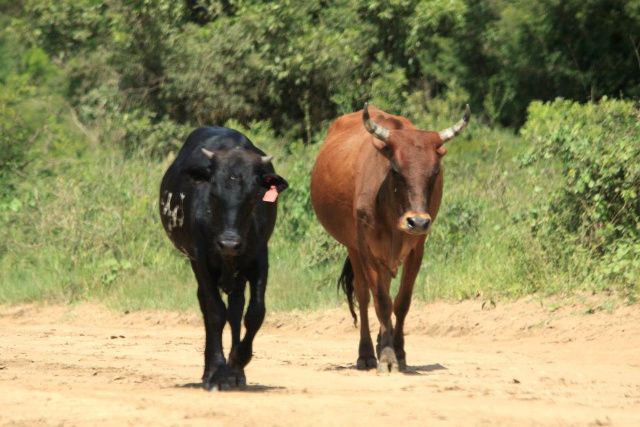
These are the Nguni cattle, an indigenous breed and extremely hardy.
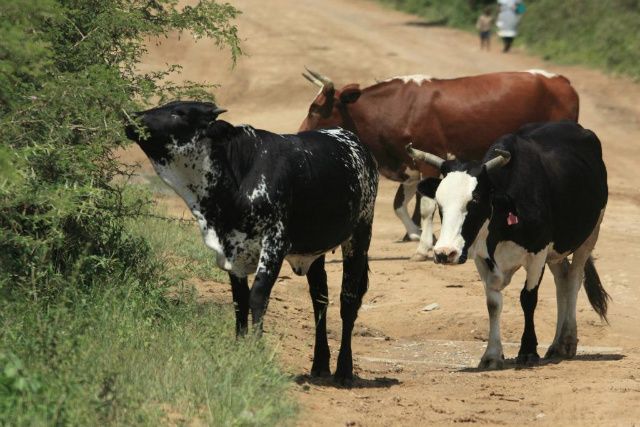
More shots of the Nguni cattle. They must be hardy to chew some of those spiked bushes!
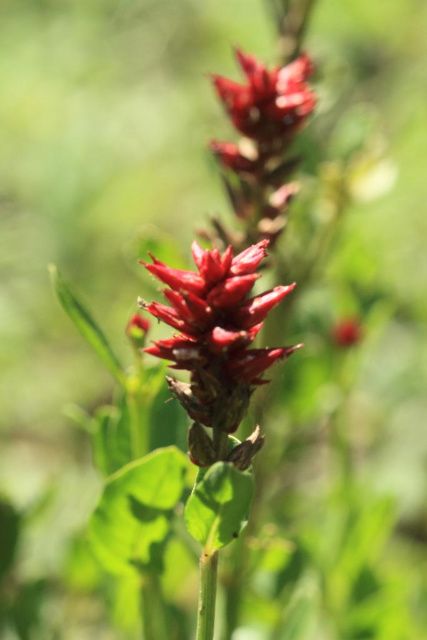
Some of the wildflowers at the edges of the Muzi Pan lake.
There were plenty of water birds at the lake but all only viewable in the scope.
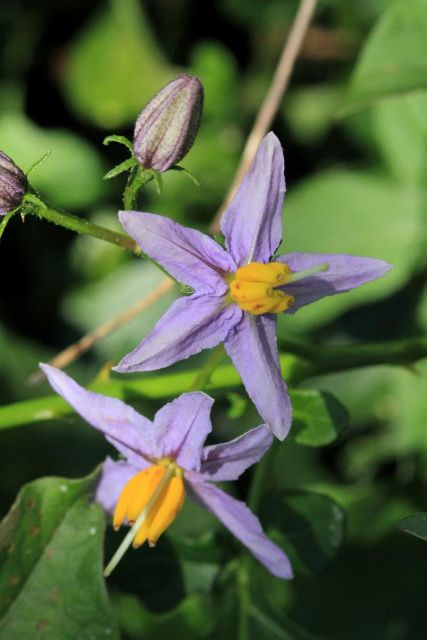
More of some of the pretty wildflowers at the Muzi Pan Lake.
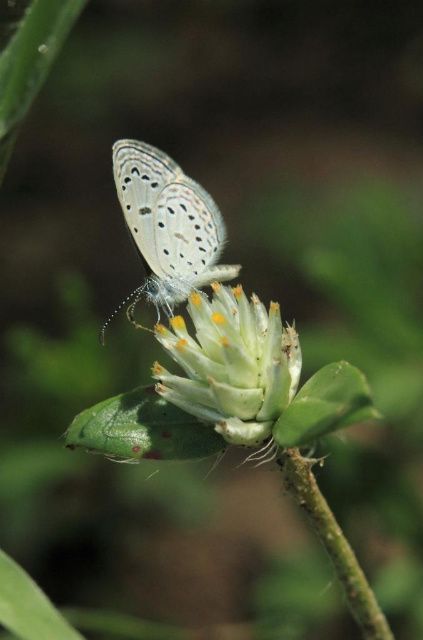
This is a Gaika Blue - several of these very small blues were on the low-grass and clover at the lake.

Also at the Muzi Pan lake, this very pretty but quite small Copper kept me amused but confused as to it's ID.
I've concluded it is the female Common Scarlet butterfly - later in the week we would see a male of the species.

The interior of the female Common Scarlet. The tails are a bit of a help regarding the ID...
After leaving Mkuze it was a drive of around two hours to our accommodation at St Lucia (the town is right on the eastern coast and borders on the Indian Ocean). We stopped for a late lunch at Ilala weavers, a lovely building with hand-made gifts made by, and helping support, the local Zulu home workforce. There were also a few butterflies in the gardens of the centre so I got another chance to try and photograph the Citrus Swallowtails in the grass outside! Leaving the centre there was the sad sight of a Rock Monitor lizard dead in the road just steps outside the centre gates, obviously recently run down by a careless driver (the Lizard must have been about 5 feet long so you could hardly miss it).
On our arrival on the outskirts of St Lucia around 6pm we stopped at the road that crosses the St Lucia estuary. Here we saw thousands of swifts just above the bridge, a few Crocodiles surveying the river currents for food, and also the majestic site of the Giant Kingfisher flying across the estuary and then after perching on the far bank (several hundred yards away), fly up-river to disappear beneath the bridge. We arrived at our guesthouse in St Lucia as the evening light was drawing in and we were quite ready to unpack. Again the accommodation was very pretty, comfortable and welcoming. That evening we had a very nice meal in the local Portuguese restaurant: the unusual sight of meat hanging from large skewers for one of the meat dishes, plus sparks flying (literally) from unfinished electrics on the outside of the building next door to the restaurant made for some good meal-time conversation (until it rained and we had to move inside the restaurant!).
For Wednesday (tomorrow) I was promised a walk through the local forest with one of the rangers who had been taking some tips from Steve Woodhall, so the prospect of some different butterflies sent me to bed happy (somewhat tired too).
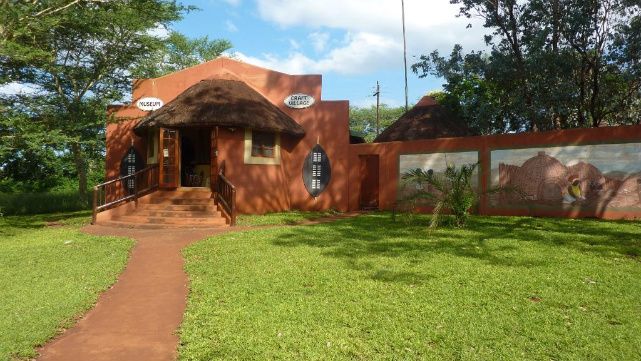
The Ilala Weavers museum and craft complex, on the way to St Lucia.
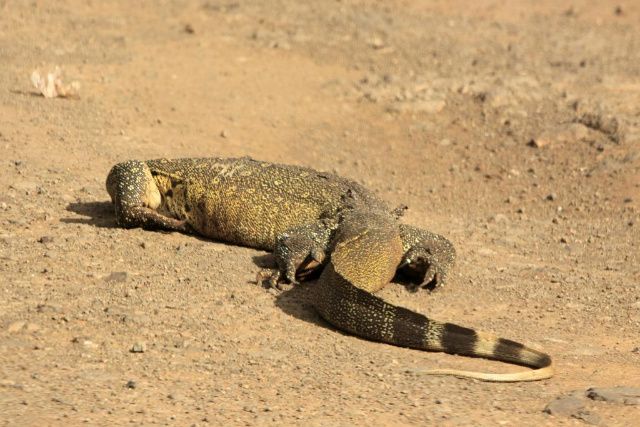
The unfortunate Rock Monitor Lizard just outside our stop at the Ilala weavers centre on the way to St Lucia.
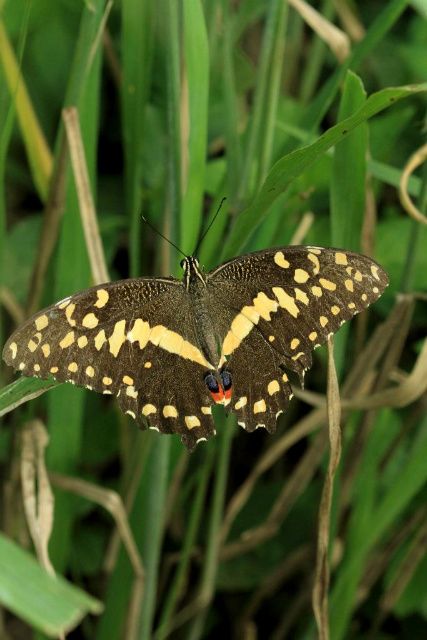
Again the Citrus Swallowtail proved a fairly common butterfly - as the afternoon got later, at least this one was stopping in the grass.

I'm not sure this quite works, but thought I'd add it in anyway.
This is the sequence of the Giant Kingfisher, photographed from across the estuary as we stopped just before St Lucia.
Just before leaving our hosts guesthouse, I was shown one of the local Leopard Tortoises that were one of the ‘small five’ of South Africa. Another great creature I saw at the house were the many dung beetles that could be seen hard at work on the dry soil, gathering their daily bit of faecal matter...they were such hard, speedy workers I couldn’t even get a good photo of them. And it was time to leave!
Our guide, Bert, stopped off twice while driving through to the South-East exit of the Mkuze reserve: once to check out one of the small hides, and once next to a small lake (Muze Pan) right by the edge of the forest boundary. For the first stop by the hide – while the rest of the group went to the hide, Karen and I checked out the butterflies that were flying about on the scrub edges of the car-park by the hide entrance: there were a pair of the Club-Tailed Emperors in the trees (the species that had been attracted to the fruit-trap the previous day), plus several whites and also some fleeting re-appearance of the Green-Banded Swallowtails that again wouldn’t stop for any reasonable length of time. If there were disadvantages in to trying to see the larger butterflies in the Mkuze reserve and grasslands, one of those would be the lack of any large flowering bushes to slow down large butterflies such the Swallowtails. Also on our drive out of the Mkuze reserve we would finally see a few butterflies mud-puddling or feeding off the remains of the animal scats. Proof that it was a hot day, rather than just humid!

Dung Beetles doing what comes naturally to them, just outside our hosts guesthouse at Mkuze.

One of the 'small five' in South Africa - the Leopard Tortoise. A surprisingly quick mover!

The male Club-Tailed Emperor viewed in one of the small hide car-parks at Mkuze.
A beautiful butterfly, but like our Emperors, quite keen to stay out of good camera-shot.

The female Club-Tailed Emperor at the same spot. A very different colour, but the same outline.

Also at the same spot was this Zebra White. Temperatures are quite hot by this point and all the butterflies are skittish!

A Blue Pansy at the same location. Slightly out-of-focus unfortunately, but quite pretty nonetheless...

These are two Crimson Tip butterflies mating: the male is a lot bigger and brighter.

Driving onward towards the southeastern edge of Mkuze, there are finally a few butterflies either mud-puddling or dung-revelling..
Our second stop out of the Mkuze reserve was at the small lake at Muzi Pan (bordering on the Isimangaliso Wetland Park World Heritage Site). This was a good stop for the bird-watchers as there were several interesting birds such as in the lake (including Pelican, Cormorant, Heron, Egret, Stork Ibis and duck), a single Malachite Kingfisher (very small) and also several Hippopotamus just under the water’s surface. These were mostly quite a distance away and seeing the birds through the scope was the only really good way of observing them. While the group were looking at the birds, I would however wander round the low-grass and scrub just on the edges of the lake (you can see a pattern emerging here). Walking round the lake’s edge I found several small Blues and also a beautiful small Copper that I wouldn’t identify until I returned home. After leaving the south-eastern edge of the Mkuze reserve we had the chance to see plenty of the local villagers near Hluhluwe: Bert explained that their Nguni cattle were indigenous and renowned for their hardiness (in some cases if the Nguni cattle were born with particular pattern / colours they would immediately be seen as belonging to the line of Zulu royalty).

Local Village girls as we edge into the end of the Mkuze Reserve and approach the Isimangaliso Wetland Park World Heritage Site.

These are the Nguni cattle, an indigenous breed and extremely hardy.

More shots of the Nguni cattle. They must be hardy to chew some of those spiked bushes!

Some of the wildflowers at the edges of the Muzi Pan lake.
There were plenty of water birds at the lake but all only viewable in the scope.

More of some of the pretty wildflowers at the Muzi Pan Lake.

This is a Gaika Blue - several of these very small blues were on the low-grass and clover at the lake.

Also at the Muzi Pan lake, this very pretty but quite small Copper kept me amused but confused as to it's ID.
I've concluded it is the female Common Scarlet butterfly - later in the week we would see a male of the species.

The interior of the female Common Scarlet. The tails are a bit of a help regarding the ID...
After leaving Mkuze it was a drive of around two hours to our accommodation at St Lucia (the town is right on the eastern coast and borders on the Indian Ocean). We stopped for a late lunch at Ilala weavers, a lovely building with hand-made gifts made by, and helping support, the local Zulu home workforce. There were also a few butterflies in the gardens of the centre so I got another chance to try and photograph the Citrus Swallowtails in the grass outside! Leaving the centre there was the sad sight of a Rock Monitor lizard dead in the road just steps outside the centre gates, obviously recently run down by a careless driver (the Lizard must have been about 5 feet long so you could hardly miss it).
On our arrival on the outskirts of St Lucia around 6pm we stopped at the road that crosses the St Lucia estuary. Here we saw thousands of swifts just above the bridge, a few Crocodiles surveying the river currents for food, and also the majestic site of the Giant Kingfisher flying across the estuary and then after perching on the far bank (several hundred yards away), fly up-river to disappear beneath the bridge. We arrived at our guesthouse in St Lucia as the evening light was drawing in and we were quite ready to unpack. Again the accommodation was very pretty, comfortable and welcoming. That evening we had a very nice meal in the local Portuguese restaurant: the unusual sight of meat hanging from large skewers for one of the meat dishes, plus sparks flying (literally) from unfinished electrics on the outside of the building next door to the restaurant made for some good meal-time conversation (until it rained and we had to move inside the restaurant!).
For Wednesday (tomorrow) I was promised a walk through the local forest with one of the rangers who had been taking some tips from Steve Woodhall, so the prospect of some different butterflies sent me to bed happy (somewhat tired too).

The Ilala Weavers museum and craft complex, on the way to St Lucia.

The unfortunate Rock Monitor Lizard just outside our stop at the Ilala weavers centre on the way to St Lucia.

Again the Citrus Swallowtail proved a fairly common butterfly - as the afternoon got later, at least this one was stopping in the grass.

I'm not sure this quite works, but thought I'd add it in anyway.
This is the sequence of the Giant Kingfisher, photographed from across the estuary as we stopped just before St Lucia.
Re: South Africa trip with Naturetrek (10-18 March)
Tremendously interesting and comprehensive report Michael, as always your fine photography and attention to detail shines through, it can't be at all easy getting all those ID's correct, butterflies alone must be some task, never mind all the other incredible critters you saw. There's not much more that I can add than the other commentators above hav'nt already, so I'll say no more for now. Very well done and I'm so pleased that you and Karen obviously had a super time and as a bonus brought home some of that Springbok sunshine 
Hope you realise that you'll be Blurbing another book out pretty soon, just remember to put some time aside to come out to play this summer occasionally

Best Wishes,
Bill
Hope you realise that you'll be Blurbing another book out pretty soon, just remember to put some time aside to come out to play this summer occasionally
Best Wishes,
Bill
Why not visit my website at http://www.dragonfly-days.co.uk
Re: South Africa trip with Naturetrek (10-18 March)
Hi Bill,
Thanks as always, and even nicer to see you back on UKB. Spring really must be coming with your arrival!!!


The story isn't finished yet, but yes, I realise there's a book here somewhere. Shame I have to work as well otherwise it would be sooner rather than later!
I will be coming out to play soon, don't you worry!
Michael
Thanks as always, and even nicer to see you back on UKB. Spring really must be coming with your arrival!!!
The story isn't finished yet, but yes, I realise there's a book here somewhere. Shame I have to work as well otherwise it would be sooner rather than later!
I will be coming out to play soon, don't you worry!
Michael
- Dave McCormick
- Posts: 2388
- Joined: Fri Mar 16, 2007 8:46 pm
- Location: Co Down, Northern Ireland
- Contact:
Re: South Africa trip with Naturetrek (10-18 March)
Great reading and love the images, thanks for sharing. Love the different butterflies, especially the Common Scarlet and different Orange and Scarlet-tip butterflies.
Cheers all,
My Website: My new website: http://daveslepidoptera.com/ - Last Update: 11/10/2011
My Nature videos: http://www.youtube.com/user/DynamixWarePro
My Website: My new website: http://daveslepidoptera.com/ - Last Update: 11/10/2011
My Nature videos: http://www.youtube.com/user/DynamixWarePro
Re: South Africa trip with Naturetrek (10-18 March)
St Lucia, Igwala Gwala Forest Trail (Wednesday, 14th March)
Again we would have a relatively early start and left our accommodation just before 7am and headed straight towards one of the local forests that were within walking distance from our gated community at St Lucia. The walk still took about half an hour to the entrance of the forest trail and on the way we would see several local birds such as the Common Indian Myna and the African Pied Wagtail – these seemed to be checking out the insect/worm life on the cultivated lawns outside each of the houses’ gates. There also seemed to be a quite large community of early-morning dog-walkers heading in the same direction as us: luckily they disappeared in another direction just before we got to the start of the iGwala Gwala forest trail that we would follow.
The walk was fairly straightforward but with a heavy woodland canopy, so the light was very low and dull as we started through the forest. Our guide Bert would listen to the early morning calls and point out every bird in the forest – though I found that it was a bit difficult to see anything clearly, and certainly to photograph anything. Eventually some sunshine started to break through at around 8:30am, when we would see several Red Squirrels up in the canopy, along with distant Hornbill, Doves and Toracos. There were a few woodland butterflies just waking up and I managed a few photographs before we headed back for breakfast: on the way back we would see some banded Mongoose crossing the road in the distance, a few of the Vervet Monkeys up in the tree canopy, and a lovely African Hoopoe on one of the lawns where Richard and I, who were hanging at the back of our group, would get a very nice close view.
Our guide for the morning, Amon, would join us back at the B&B and we would get out again for the iGwala Gwala forest walk around 10:30.
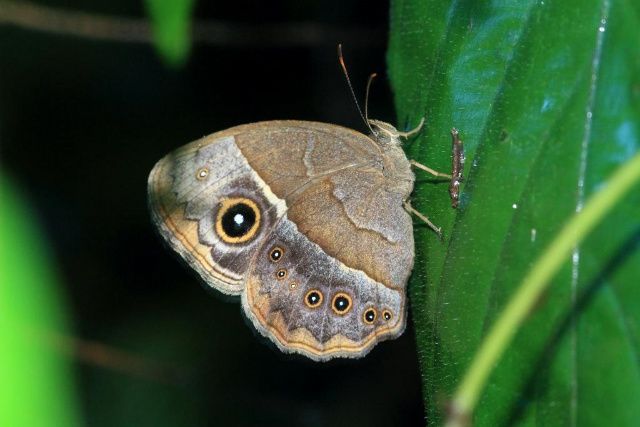
A Squinting Bush Brown was the first butterfly I saw on the iGwala Gwala forest trail.
It flew across the main walk to hide amongst the bushes, no doubt until the weather warmed up later.
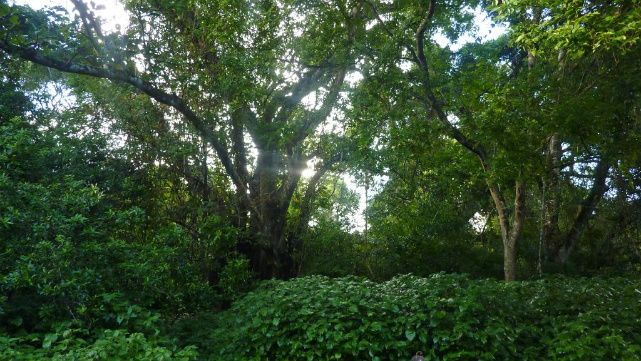
A few of the typical woodland bushes alongside the St Lucia iGwala Gwala forest trail.

There continued to be some excellent other insects to see, including this cricket amongst the bushes.
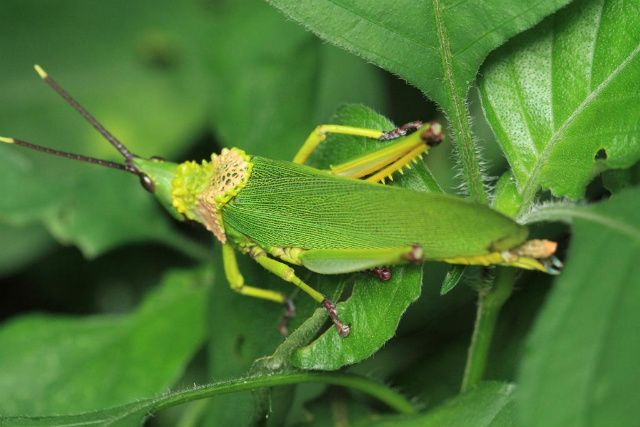
Another view of the same Cricket. No doubt it would make a tasty meal for something...
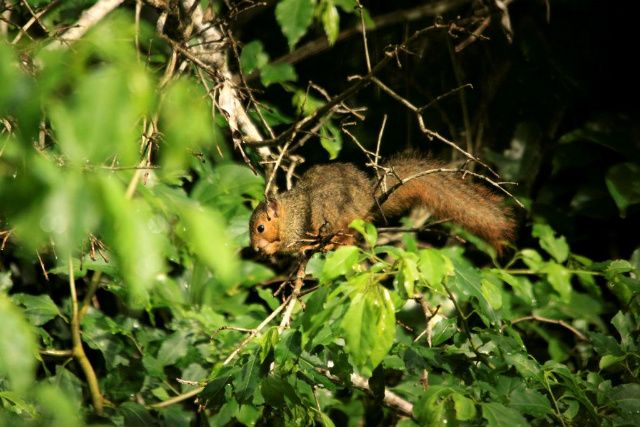
When the sun broke through for about ten minutes we saw several Red Squirrels in the forest canopy.
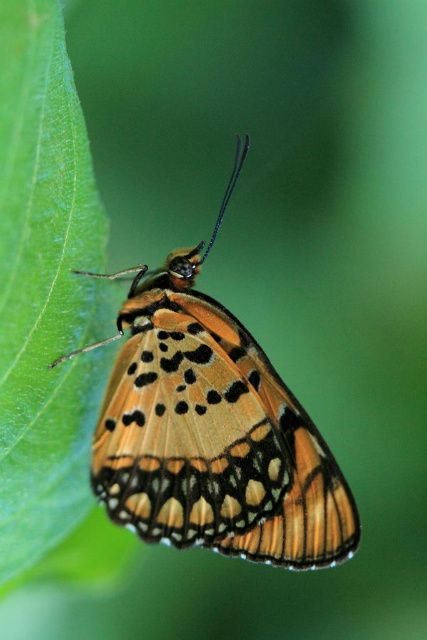
This Spotted Joker also flew across in the main ride. We'd seen several at Mkuze reserve but this was the first time one had stopped.
Shame that the light was still low - I managed a half-decent shot before catching the rest of the group up!
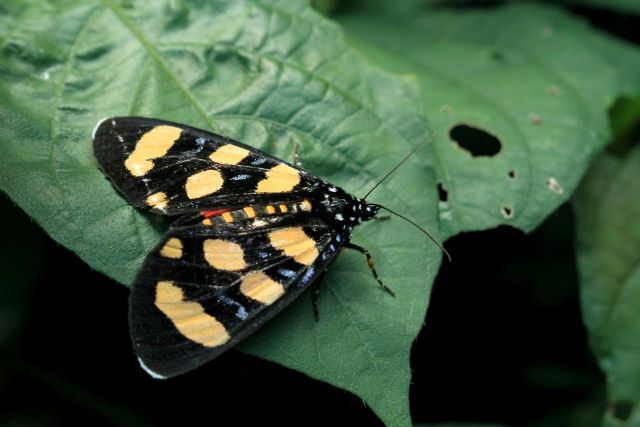
A pretty, but unidentified moth - it looks a little like some of our Tiger Moths.
n.b. Later identified by Steve Woodhall as an 'African False Tiger' moth (!)
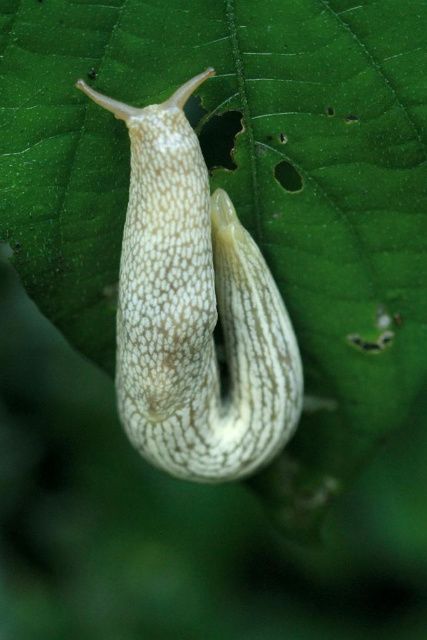
I think our guide, Bert, described this as a 'naked slug', but I'm calling it a White Leopard Slug for the moment as I may have mis-heard him!

Some butterflies stayed at a distance in the forest only letting us get the briefest of views.
This is a Streaked Sailor, very similiar to the european Gliders.

Walking back from the forest for breakfast, there were several Vervet Monkeys up in the tree canopy.
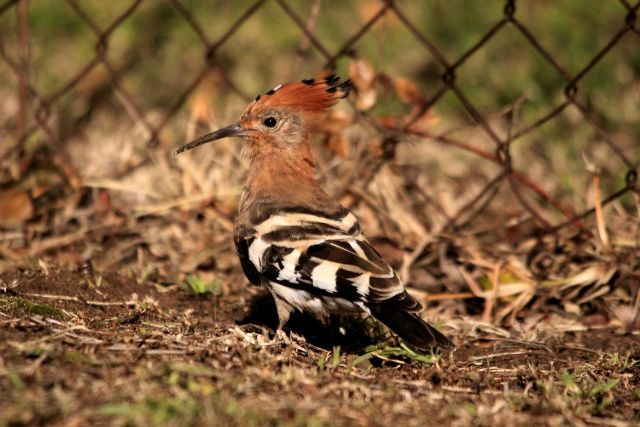
The lovely African Hoopoe on the way back to our B&B. It was definitely more interested in what it could eat on the lawns.
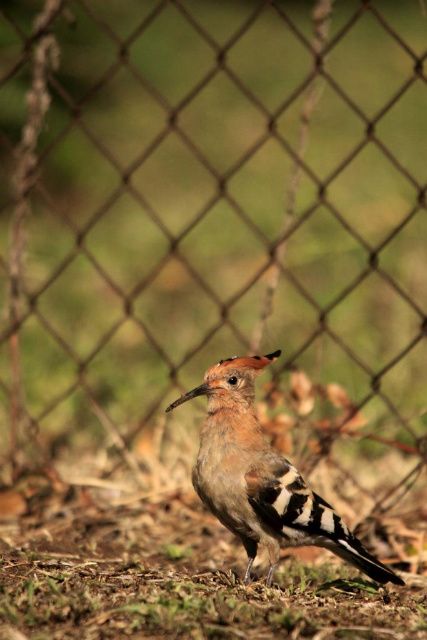
Shame about the background of the fence, but you can't have everything..
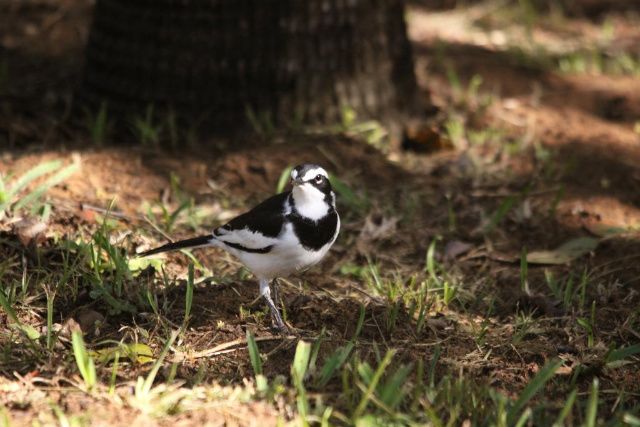
Also visiting the lawns in our gated community were several African Pied Flycatchers.
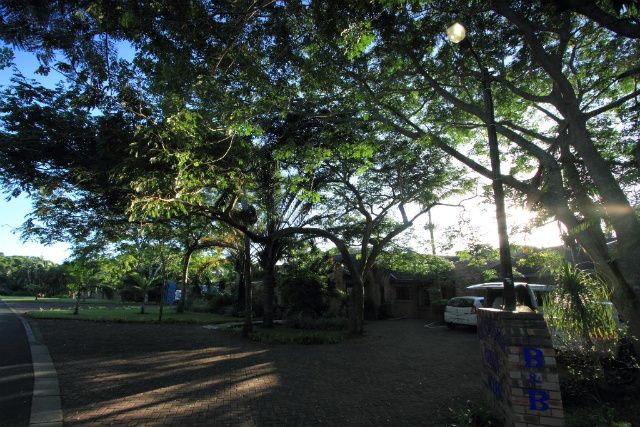
Our accomodation back in St Lucia - another pleasant surprise - was a great place to stay.

Our breakfast was out next to the B&B's swimming pool / garden, under a pleasant thatched covering.
Again we would have a relatively early start and left our accommodation just before 7am and headed straight towards one of the local forests that were within walking distance from our gated community at St Lucia. The walk still took about half an hour to the entrance of the forest trail and on the way we would see several local birds such as the Common Indian Myna and the African Pied Wagtail – these seemed to be checking out the insect/worm life on the cultivated lawns outside each of the houses’ gates. There also seemed to be a quite large community of early-morning dog-walkers heading in the same direction as us: luckily they disappeared in another direction just before we got to the start of the iGwala Gwala forest trail that we would follow.
The walk was fairly straightforward but with a heavy woodland canopy, so the light was very low and dull as we started through the forest. Our guide Bert would listen to the early morning calls and point out every bird in the forest – though I found that it was a bit difficult to see anything clearly, and certainly to photograph anything. Eventually some sunshine started to break through at around 8:30am, when we would see several Red Squirrels up in the canopy, along with distant Hornbill, Doves and Toracos. There were a few woodland butterflies just waking up and I managed a few photographs before we headed back for breakfast: on the way back we would see some banded Mongoose crossing the road in the distance, a few of the Vervet Monkeys up in the tree canopy, and a lovely African Hoopoe on one of the lawns where Richard and I, who were hanging at the back of our group, would get a very nice close view.
Our guide for the morning, Amon, would join us back at the B&B and we would get out again for the iGwala Gwala forest walk around 10:30.

A Squinting Bush Brown was the first butterfly I saw on the iGwala Gwala forest trail.
It flew across the main walk to hide amongst the bushes, no doubt until the weather warmed up later.

A few of the typical woodland bushes alongside the St Lucia iGwala Gwala forest trail.

There continued to be some excellent other insects to see, including this cricket amongst the bushes.

Another view of the same Cricket. No doubt it would make a tasty meal for something...

When the sun broke through for about ten minutes we saw several Red Squirrels in the forest canopy.

This Spotted Joker also flew across in the main ride. We'd seen several at Mkuze reserve but this was the first time one had stopped.
Shame that the light was still low - I managed a half-decent shot before catching the rest of the group up!

A pretty, but unidentified moth - it looks a little like some of our Tiger Moths.
n.b. Later identified by Steve Woodhall as an 'African False Tiger' moth (!)

I think our guide, Bert, described this as a 'naked slug', but I'm calling it a White Leopard Slug for the moment as I may have mis-heard him!

Some butterflies stayed at a distance in the forest only letting us get the briefest of views.
This is a Streaked Sailor, very similiar to the european Gliders.

Walking back from the forest for breakfast, there were several Vervet Monkeys up in the tree canopy.

The lovely African Hoopoe on the way back to our B&B. It was definitely more interested in what it could eat on the lawns.

Shame about the background of the fence, but you can't have everything..

Also visiting the lawns in our gated community were several African Pied Flycatchers.

Our accomodation back in St Lucia - another pleasant surprise - was a great place to stay.

Our breakfast was out next to the B&B's swimming pool / garden, under a pleasant thatched covering.
Last edited by Michaeljf on Fri Apr 06, 2012 3:40 pm, edited 1 time in total.
Re: South Africa trip with Naturetrek (10-18 March)
St Lucia, Igwala Gwala Forest Trail (Wednesday, 14th March) continued
For the second session at the iGwala Gwala walk we drove to the forest in the Minibus. Bert left some fruit bait in the car park, as Amon gave a quick talk about the butterflies of South Africa, with a quick run-through of their families and the needs of butterflies, and especially the need for caterpillar food-plants. No sooner did we start the walk than Amon started stalking every possible butterfly with Bert’s butterfly net: Richard and I were slightly worried (horrified) as this was rather going to spoil any chances of ‘natural’ photographs – I certainly don’t like seeing butterflies netted - so we did discourage Amon slightly from trying to net everything! To be fair to Amon, he is a very likeable and knowledgeable guide / ranger and I think the netting is quite the ‘standard’ practice for rangers for helping with identification..
First up on the walk were several skippers and we could see quite a few large Swallowtails in the distant canopy, though many of the butterflies were still staying away from the main path as I noted there were no big ‘nectar’ or even fruit sources to encourage them down to ground level. Again, a number of Whites and the Sailers would be flying around without stopping for very long. We ventured down to a more open field just on the edge of one of the estuary lakes: here there were at least some good spots in the sunshine for the whites to stop on the path to pick up salts, though even now, they were reticent to stay put when we approached them. Also this bit of flat land was used for a picnic area and unfortunately the area had been closely mown so no natural small flowers were growing here. At the path entrances from the forest to the open ground there were at least some of the Skippers playing out typical lekking behaviour - finding an important perch and coming back to it several times.
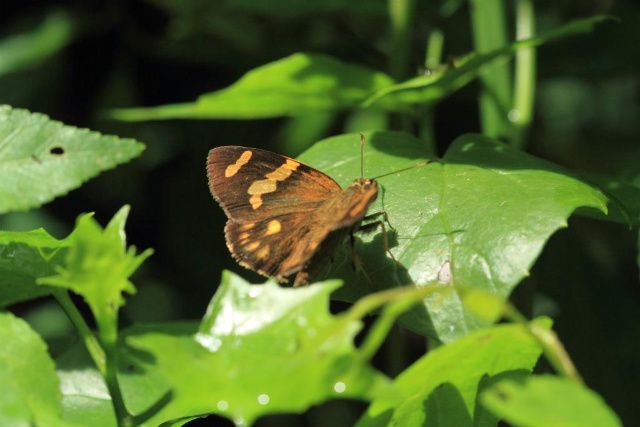
One of the first butterflies on the return trip to the iGwala Gwala forest trail was this Large Sprite (Pyrginae family).
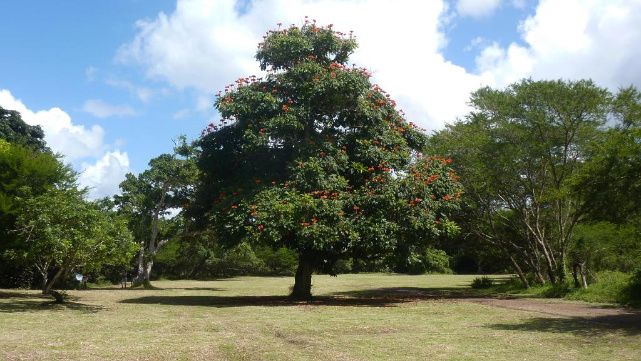
The open flat field near the Estuary proved a good place to stop and look for butterflies.
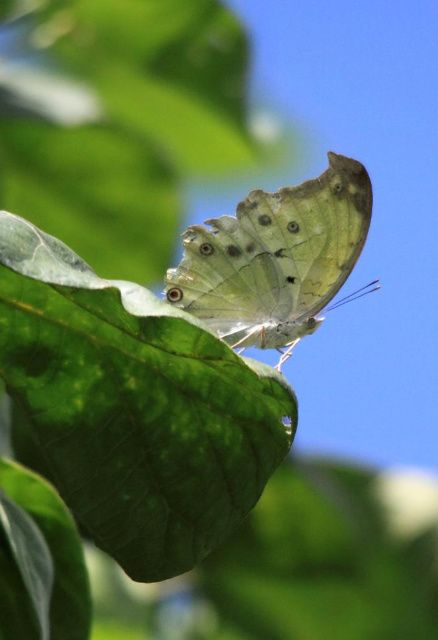
A Common Mother of Pearl was one of the few larger butterflies that stopped in the field long enough for a *distance* photo.
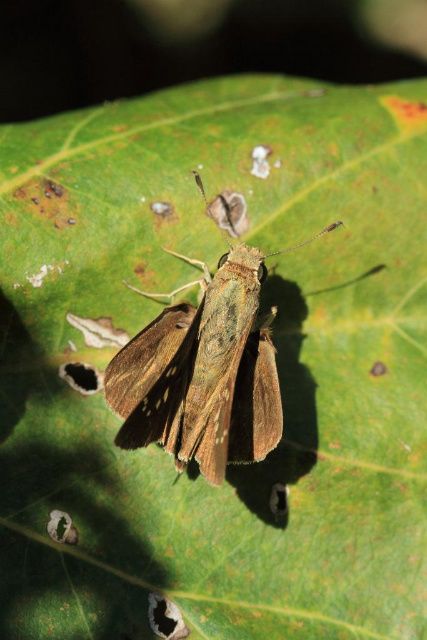
First identified as a Hottentot Skipper, but Steve Woodhall tells me this is another species of Pyrginae (tbc!)

A better underside shot of the Skipper showing the lighter markings on its wings.
Amon and the party headed for one side of the field and me to another: Amon would net a beautiful Citrus Swallowtail (very newly hatched) while I would see some more of the Purple-Brown Hairstreaks, various Skippers and a few more of the Browns that were quite common in the forest. There were also some Emperors flying near to the bushes that edged the lake (identified later as White-Barred and Pearl Emperor) though I could never seem to get a photo: perhaps I should have encouraged Amon to use his net here (!) and at least I would have got some evidence of these Charaxinae. I think Richard may have got a photo, at least: but soon some thick cloud came over and my chances for the moment in the forest were gone. I was tempted to stay at this spot for longer, but our guide Bert persuaded us we should move on to our next visit for the day.
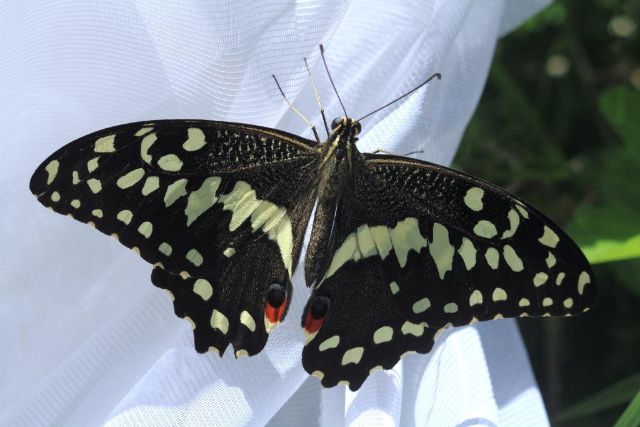
Our guide in the forest, Amon, netted this very fresh Citrus Swallowtail. We got a photo before the individual flew off again.
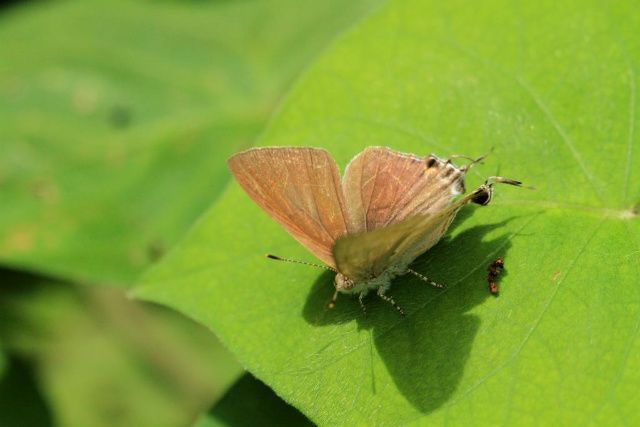
On the bushes by the edge of the Estuary were more smaller butterflies, including this slightly taggy Purple-Brown Hairstreak.
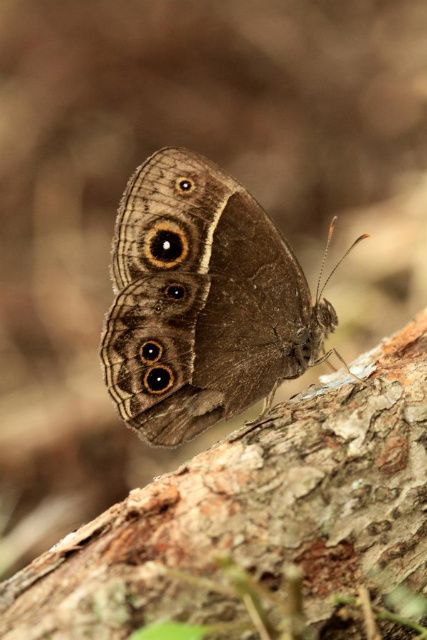
Also under the shade was another Squinting Bush Brown. No surprise there were plenty of these in the forest.
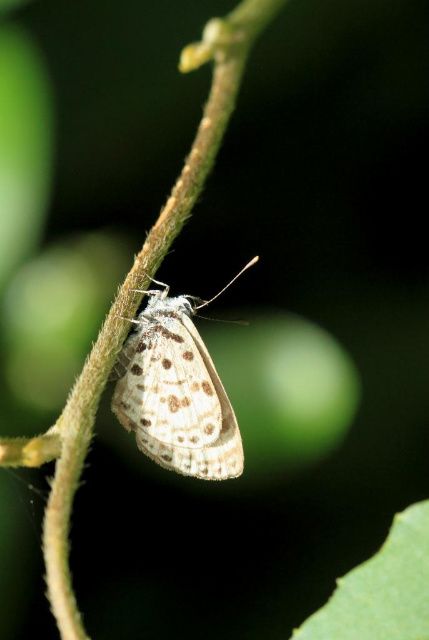
I've noted this as a Thorn-tree Blue, in the same spot as the Hairstreak and the Emperors (not photographed!).

Amon shows discusses another specimen to the group before releasing it.
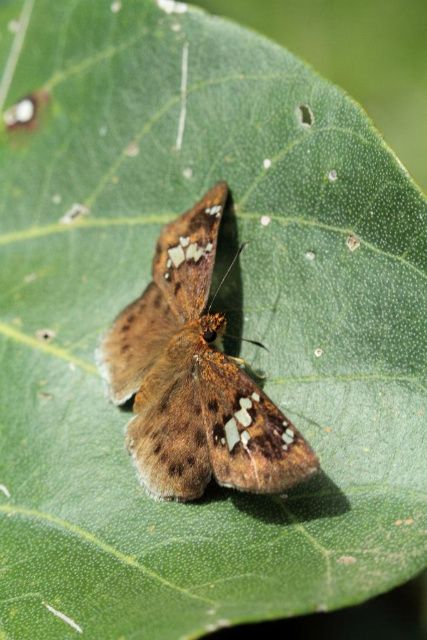
Another of the Skippers at the edges of the field: this one a Clouded Flat (sometimes called Clouded Forester or Clouded Skipper).

One of the many Red Millipedes seen as we left the iGwala Gwala forest trail for the second time.
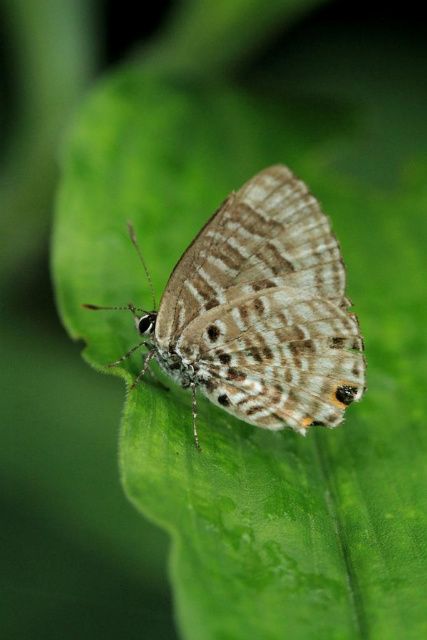
One of the small Lycaenids as we left the forest: not sure on this one, it may be a Little Hairtail (lost its tails though!)
n.b.: Later identified by Steve Woodhall as a (female) Spotted Hairtail (previously known as a Kersten's Hairtail).
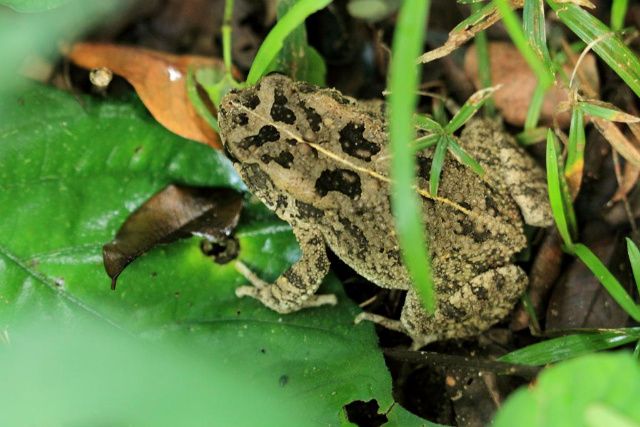
One of the Toads that was jumping into the bushes on the path of the forest floor.
For the second session at the iGwala Gwala walk we drove to the forest in the Minibus. Bert left some fruit bait in the car park, as Amon gave a quick talk about the butterflies of South Africa, with a quick run-through of their families and the needs of butterflies, and especially the need for caterpillar food-plants. No sooner did we start the walk than Amon started stalking every possible butterfly with Bert’s butterfly net: Richard and I were slightly worried (horrified) as this was rather going to spoil any chances of ‘natural’ photographs – I certainly don’t like seeing butterflies netted - so we did discourage Amon slightly from trying to net everything! To be fair to Amon, he is a very likeable and knowledgeable guide / ranger and I think the netting is quite the ‘standard’ practice for rangers for helping with identification..
First up on the walk were several skippers and we could see quite a few large Swallowtails in the distant canopy, though many of the butterflies were still staying away from the main path as I noted there were no big ‘nectar’ or even fruit sources to encourage them down to ground level. Again, a number of Whites and the Sailers would be flying around without stopping for very long. We ventured down to a more open field just on the edge of one of the estuary lakes: here there were at least some good spots in the sunshine for the whites to stop on the path to pick up salts, though even now, they were reticent to stay put when we approached them. Also this bit of flat land was used for a picnic area and unfortunately the area had been closely mown so no natural small flowers were growing here. At the path entrances from the forest to the open ground there were at least some of the Skippers playing out typical lekking behaviour - finding an important perch and coming back to it several times.

One of the first butterflies on the return trip to the iGwala Gwala forest trail was this Large Sprite (Pyrginae family).

The open flat field near the Estuary proved a good place to stop and look for butterflies.

A Common Mother of Pearl was one of the few larger butterflies that stopped in the field long enough for a *distance* photo.

First identified as a Hottentot Skipper, but Steve Woodhall tells me this is another species of Pyrginae (tbc!)

A better underside shot of the Skipper showing the lighter markings on its wings.
Amon and the party headed for one side of the field and me to another: Amon would net a beautiful Citrus Swallowtail (very newly hatched) while I would see some more of the Purple-Brown Hairstreaks, various Skippers and a few more of the Browns that were quite common in the forest. There were also some Emperors flying near to the bushes that edged the lake (identified later as White-Barred and Pearl Emperor) though I could never seem to get a photo: perhaps I should have encouraged Amon to use his net here (!) and at least I would have got some evidence of these Charaxinae. I think Richard may have got a photo, at least: but soon some thick cloud came over and my chances for the moment in the forest were gone. I was tempted to stay at this spot for longer, but our guide Bert persuaded us we should move on to our next visit for the day.

Our guide in the forest, Amon, netted this very fresh Citrus Swallowtail. We got a photo before the individual flew off again.

On the bushes by the edge of the Estuary were more smaller butterflies, including this slightly taggy Purple-Brown Hairstreak.

Also under the shade was another Squinting Bush Brown. No surprise there were plenty of these in the forest.

I've noted this as a Thorn-tree Blue, in the same spot as the Hairstreak and the Emperors (not photographed!).

Amon shows discusses another specimen to the group before releasing it.

Another of the Skippers at the edges of the field: this one a Clouded Flat (sometimes called Clouded Forester or Clouded Skipper).

One of the many Red Millipedes seen as we left the iGwala Gwala forest trail for the second time.

One of the small Lycaenids as we left the forest: not sure on this one, it may be a Little Hairtail (lost its tails though!)
n.b.: Later identified by Steve Woodhall as a (female) Spotted Hairtail (previously known as a Kersten's Hairtail).

One of the Toads that was jumping into the bushes on the path of the forest floor.
Last edited by Michaeljf on Fri Apr 06, 2012 3:53 pm, edited 2 times in total.
Re: South Africa trip with Naturetrek (10-18 March)
St Lucia (Wednesday, 14th March) continued
In the early afternoon we visited a dedicated butterfly house on the outskirts of St Lucia: here they bred some of the local common species so it was easier to see at least some of the Acraea more closely: there were also some Tree-Frogs in the white-netted house, but I think these had just been fortunate and had sneaked in from the local ponds and trees, sensing an ‘easier snack’ would be had here. After the butterfly-house visit we had lunch opposite the banks of the St Lucia River: here we could see the Hippopotamus, a few ‘sneaky’ crocodiles and several Herons in the middle of the water. After a brief lunch we were driven to another reserve, though there wasn’t much new here in the way of animals: most of them had obviously wandered further away from the paths into the scrub. We passed a few Greater Kudu, Bushbuk and Waterbuck and a few dangerous looking Cape Buffalo with Wildebeest.
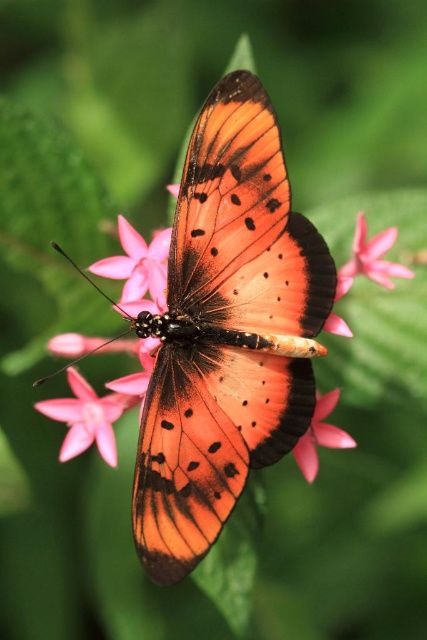
A Natal Acraea in the St Lucia butterfly house. This would also be a species you could see locally.
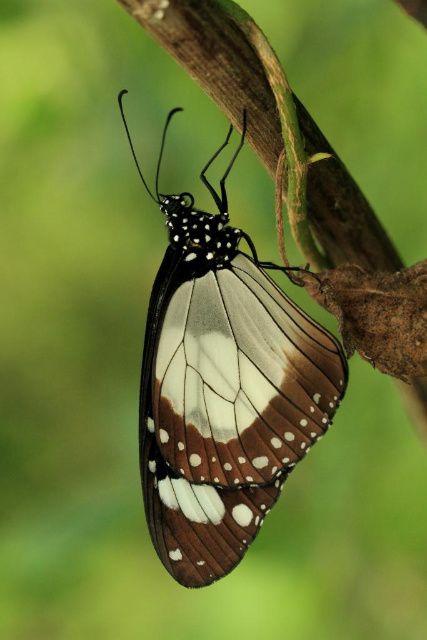
A Novice butterfly also in the St Lucia butterfly house.
It is one of the Danainae family and you can see the resemblance to the Monarch.
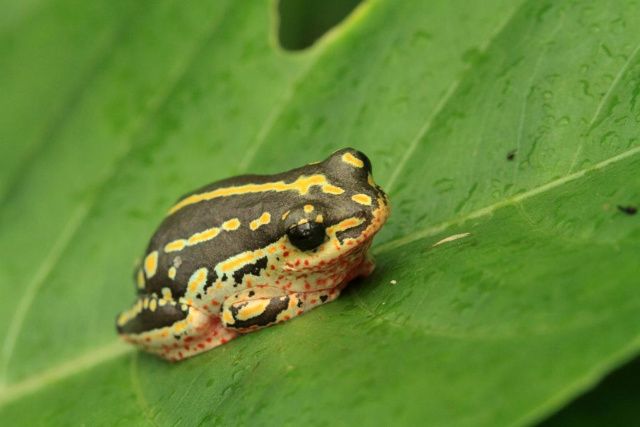
One of the Tree-Frogs that had ventured into the butterfly house.
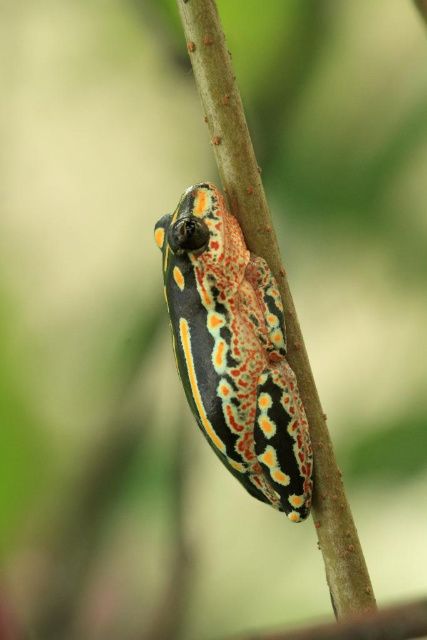
Another one of the Tree-Frogs. These weren't bred in the butterfly house on purpose - they just knew it was a good place for food...
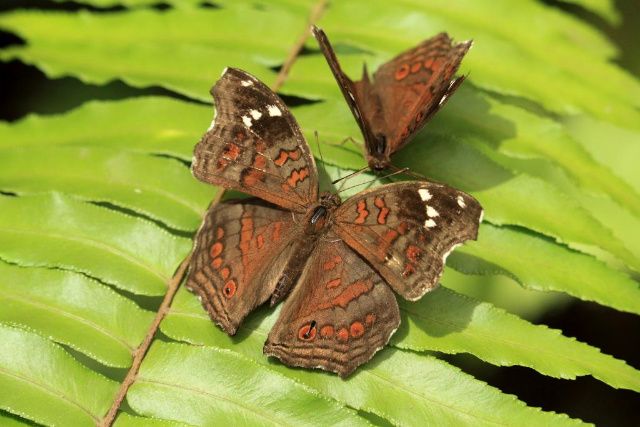
A couple of Brown Pansy butterflies in the butterfly house. I'd seen this species earlier at Mkuze.
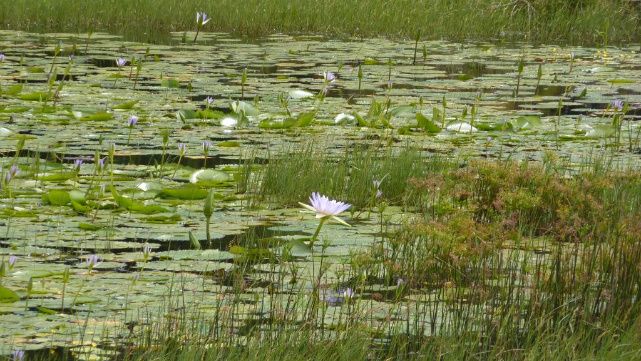
The butterfly house at St Lucia was right by one of the estuary rivers. This view shows some of the many Water-Lilies.
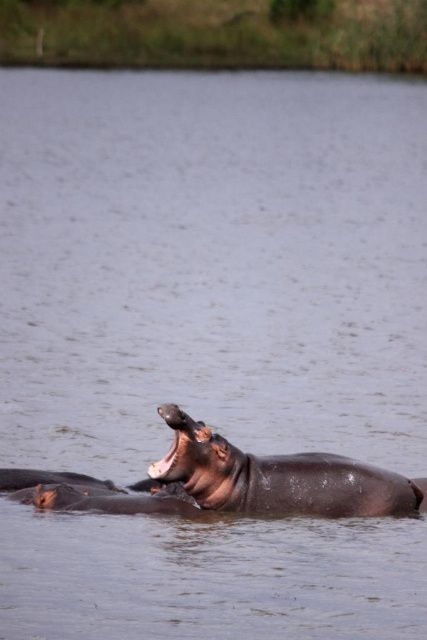
One of the Hipopotamus in the St Lucia estuary river as we ate our lunch.
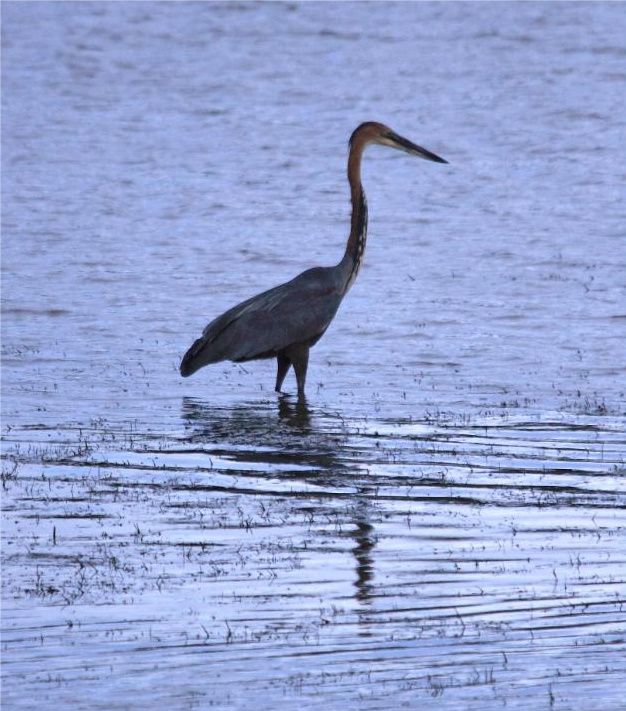
There were, of course, plenty of birds in the river. I think this is probably a Goliath Heron.
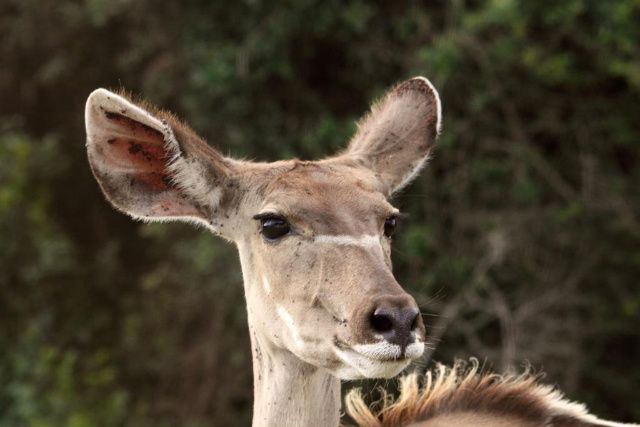
A female Greater Kudu in one of the reserves near the coast at St Lucia.
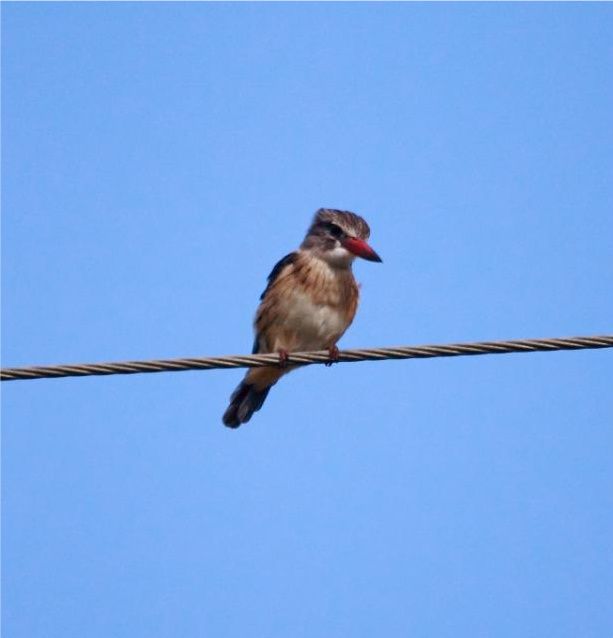
A Brown-Hooded Kingfisher also in the coastal reserve.
We would finish the afternoon right on the edge of the ocean and as everyone else was looking through their binoculars at the birds on the waters-edge, I managed to see a couple of very nice Purple-Brown Hairstreaks just catching the late afternoon warmth. There was also a very pretty Hawk-moth on the wooden rafters of the bird viewpoint by the ocean. There were quite a few of the Vervet Monkeys in the car-parks here, and plenty of healthy spiders by the paths up to some of the coastal viewpoints. Surprisingly - and despite the late burst of afternoon sunshine - the butterflies were largely absent from this reserve, at least for today. I did wonder why we had spent the end of the afternoon here when we would be driving most of the following day to St Lucia through a reserve, but then it was easy to see why I would have liked to stay in the forest next to our B&B.
We had another nice evening meal in an Italian restaurant in St Lucia, made all the better by the sight of a very large Emperor moth that flew in after being attracted to the lights of the restaurant. The moth landed on one of the diner’s shoulders and they were very pleased when I took the moth off and took it down the road away from the restaurants lights. Certainly this was the largest moth I had ever seen in the wild. Tomorrow (Thursday 15th March) we would drive through another wildlife reserve, on our way to our last residence of the trip at Eshowe, and tonight would be our last in St Lucia. I felt this was a bit of a shame - I could well have done with some more time at this excellent and welcoming town.
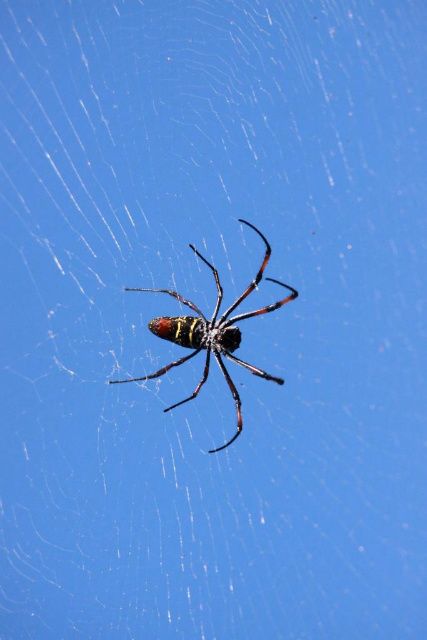
One of the many spiders at the St Lucia reserve - there were many webs by the paths to the coastal viewpoints.

A very young Vervet Monkey in one of the car-parks in the St Lucia reserve.
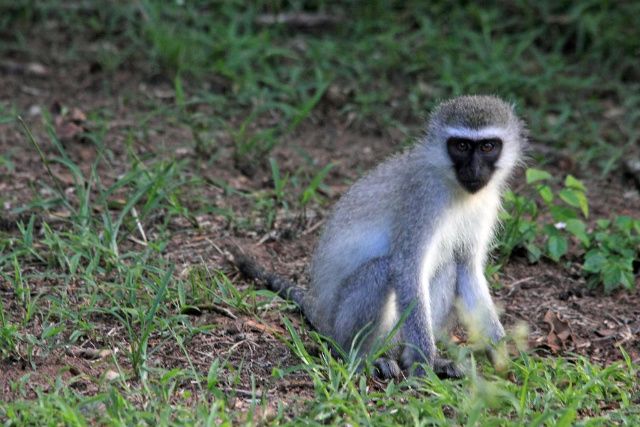
Unlike some ape species, these Monkeys stay away from people and seem to be quite shy.
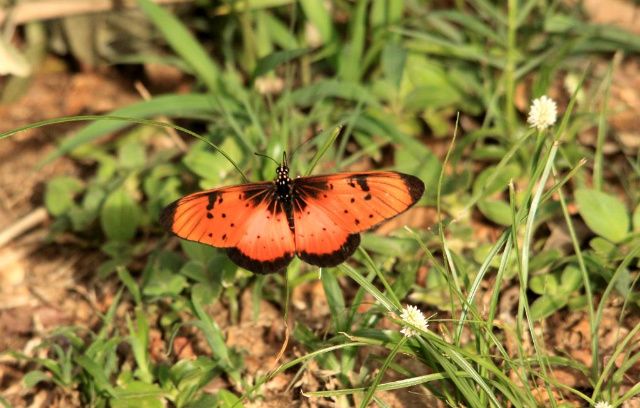
A Natal Acraea (female) on the wing in the St Lucia scrub beside the same car-park.

This spider has managed to catch one of the Dung-Beetles in its web.
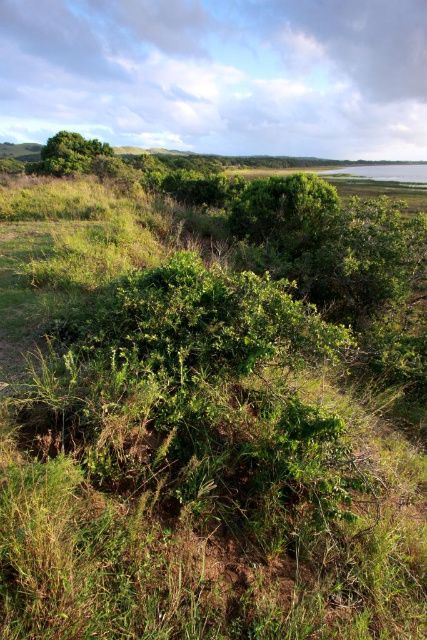
The late afternoon and the St Lucia coastline is just getting some last rays of sunshine as evening rolls in...
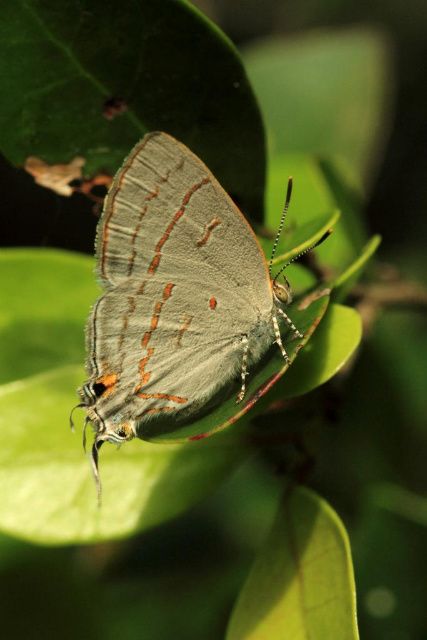
An excellent view of a Purple-Brown Hairstreak just catching the last rays of the sun at the coast.
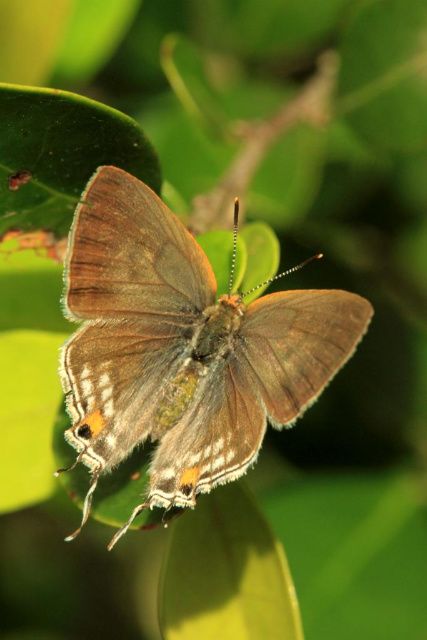
The Purple-Brown Hairstreak opens up to catch the last bit of sunshine at St Lucia.
In the early afternoon we visited a dedicated butterfly house on the outskirts of St Lucia: here they bred some of the local common species so it was easier to see at least some of the Acraea more closely: there were also some Tree-Frogs in the white-netted house, but I think these had just been fortunate and had sneaked in from the local ponds and trees, sensing an ‘easier snack’ would be had here. After the butterfly-house visit we had lunch opposite the banks of the St Lucia River: here we could see the Hippopotamus, a few ‘sneaky’ crocodiles and several Herons in the middle of the water. After a brief lunch we were driven to another reserve, though there wasn’t much new here in the way of animals: most of them had obviously wandered further away from the paths into the scrub. We passed a few Greater Kudu, Bushbuk and Waterbuck and a few dangerous looking Cape Buffalo with Wildebeest.

A Natal Acraea in the St Lucia butterfly house. This would also be a species you could see locally.

A Novice butterfly also in the St Lucia butterfly house.
It is one of the Danainae family and you can see the resemblance to the Monarch.

One of the Tree-Frogs that had ventured into the butterfly house.

Another one of the Tree-Frogs. These weren't bred in the butterfly house on purpose - they just knew it was a good place for food...

A couple of Brown Pansy butterflies in the butterfly house. I'd seen this species earlier at Mkuze.

The butterfly house at St Lucia was right by one of the estuary rivers. This view shows some of the many Water-Lilies.

One of the Hipopotamus in the St Lucia estuary river as we ate our lunch.

There were, of course, plenty of birds in the river. I think this is probably a Goliath Heron.

A female Greater Kudu in one of the reserves near the coast at St Lucia.

A Brown-Hooded Kingfisher also in the coastal reserve.
We would finish the afternoon right on the edge of the ocean and as everyone else was looking through their binoculars at the birds on the waters-edge, I managed to see a couple of very nice Purple-Brown Hairstreaks just catching the late afternoon warmth. There was also a very pretty Hawk-moth on the wooden rafters of the bird viewpoint by the ocean. There were quite a few of the Vervet Monkeys in the car-parks here, and plenty of healthy spiders by the paths up to some of the coastal viewpoints. Surprisingly - and despite the late burst of afternoon sunshine - the butterflies were largely absent from this reserve, at least for today. I did wonder why we had spent the end of the afternoon here when we would be driving most of the following day to St Lucia through a reserve, but then it was easy to see why I would have liked to stay in the forest next to our B&B.
We had another nice evening meal in an Italian restaurant in St Lucia, made all the better by the sight of a very large Emperor moth that flew in after being attracted to the lights of the restaurant. The moth landed on one of the diner’s shoulders and they were very pleased when I took the moth off and took it down the road away from the restaurants lights. Certainly this was the largest moth I had ever seen in the wild. Tomorrow (Thursday 15th March) we would drive through another wildlife reserve, on our way to our last residence of the trip at Eshowe, and tonight would be our last in St Lucia. I felt this was a bit of a shame - I could well have done with some more time at this excellent and welcoming town.

One of the many spiders at the St Lucia reserve - there were many webs by the paths to the coastal viewpoints.

A very young Vervet Monkey in one of the car-parks in the St Lucia reserve.

Unlike some ape species, these Monkeys stay away from people and seem to be quite shy.

A Natal Acraea (female) on the wing in the St Lucia scrub beside the same car-park.

This spider has managed to catch one of the Dung-Beetles in its web.

The late afternoon and the St Lucia coastline is just getting some last rays of sunshine as evening rolls in...

An excellent view of a Purple-Brown Hairstreak just catching the last rays of the sun at the coast.

The Purple-Brown Hairstreak opens up to catch the last bit of sunshine at St Lucia.
